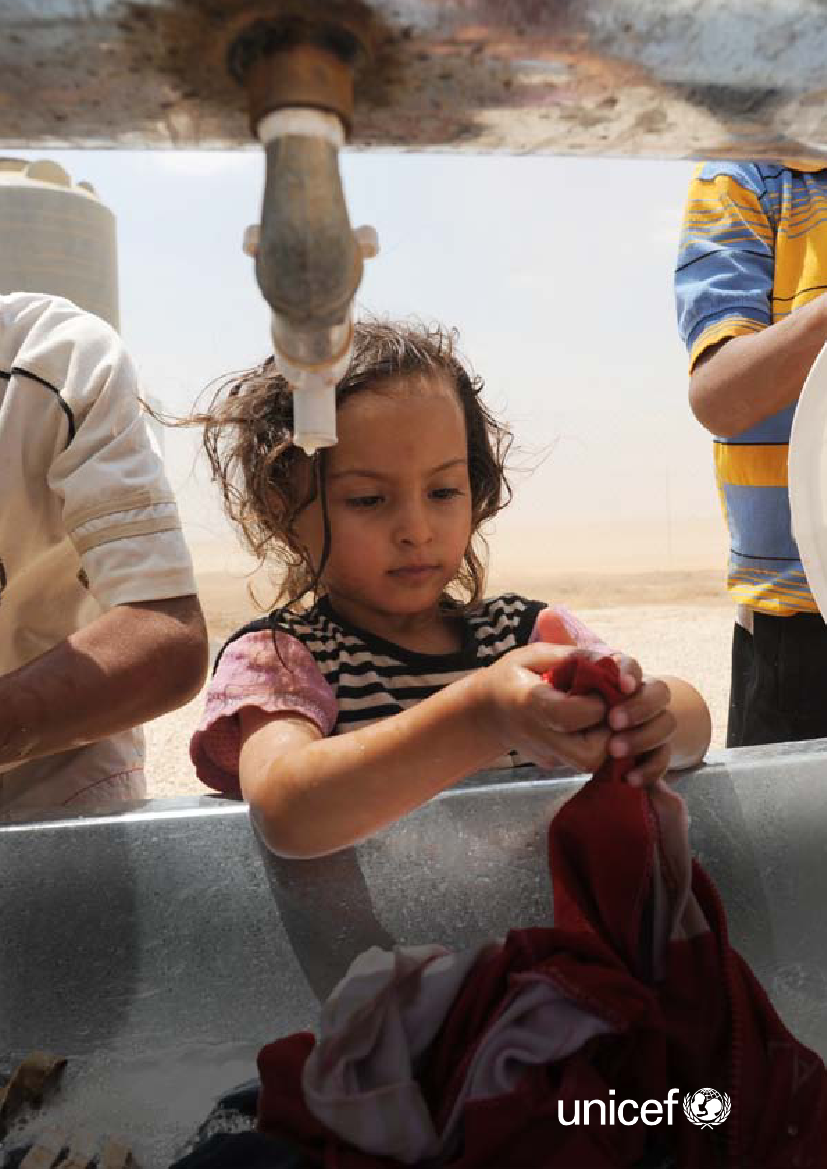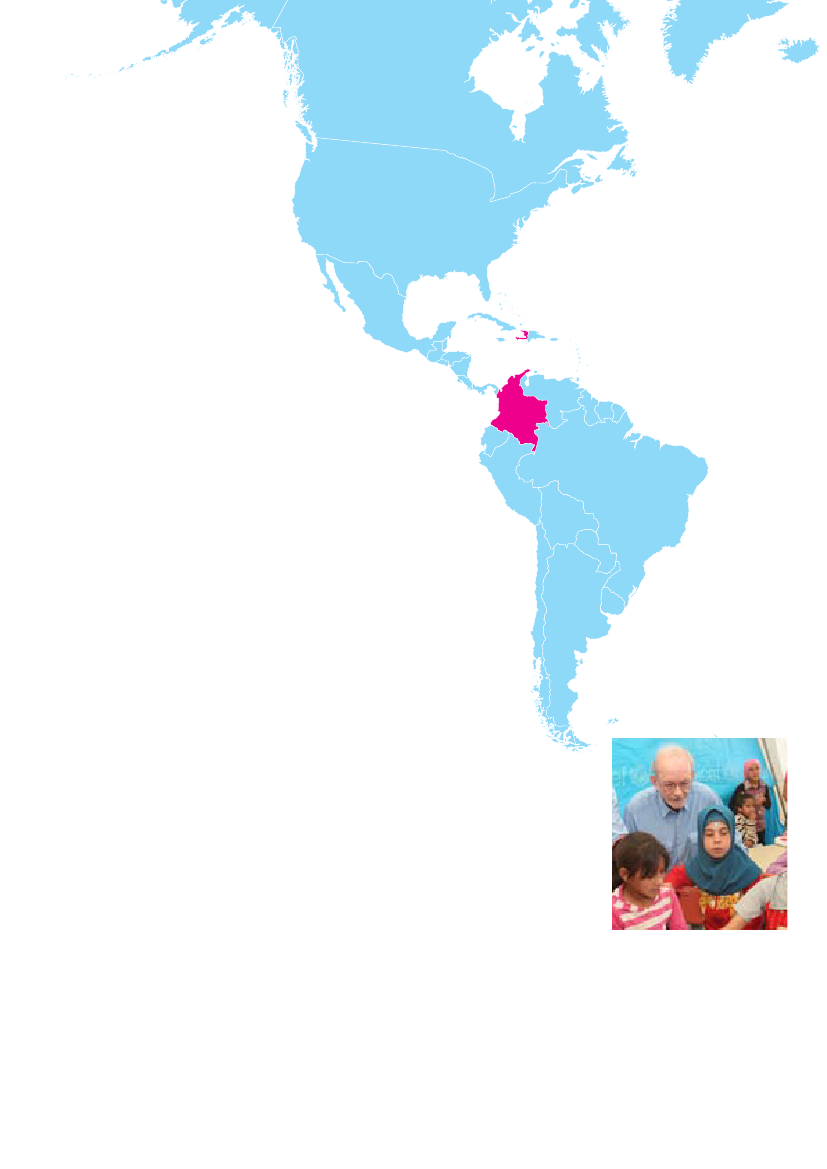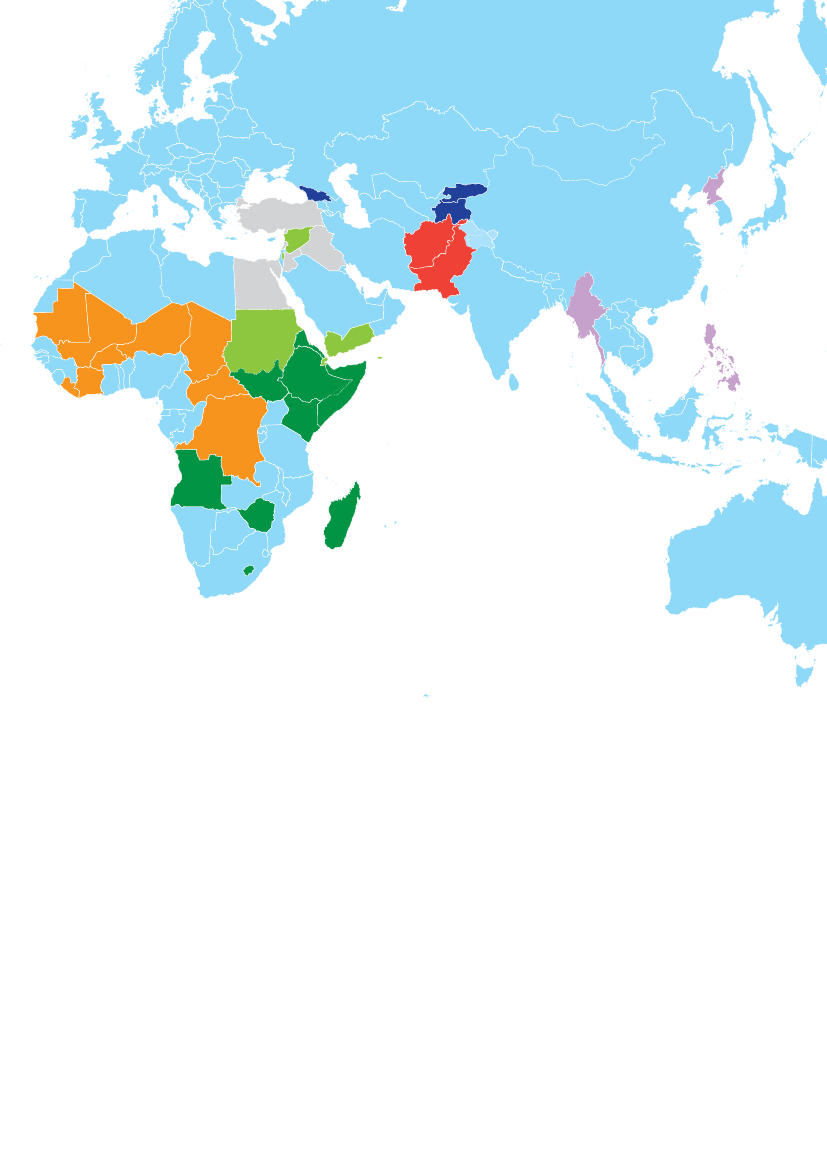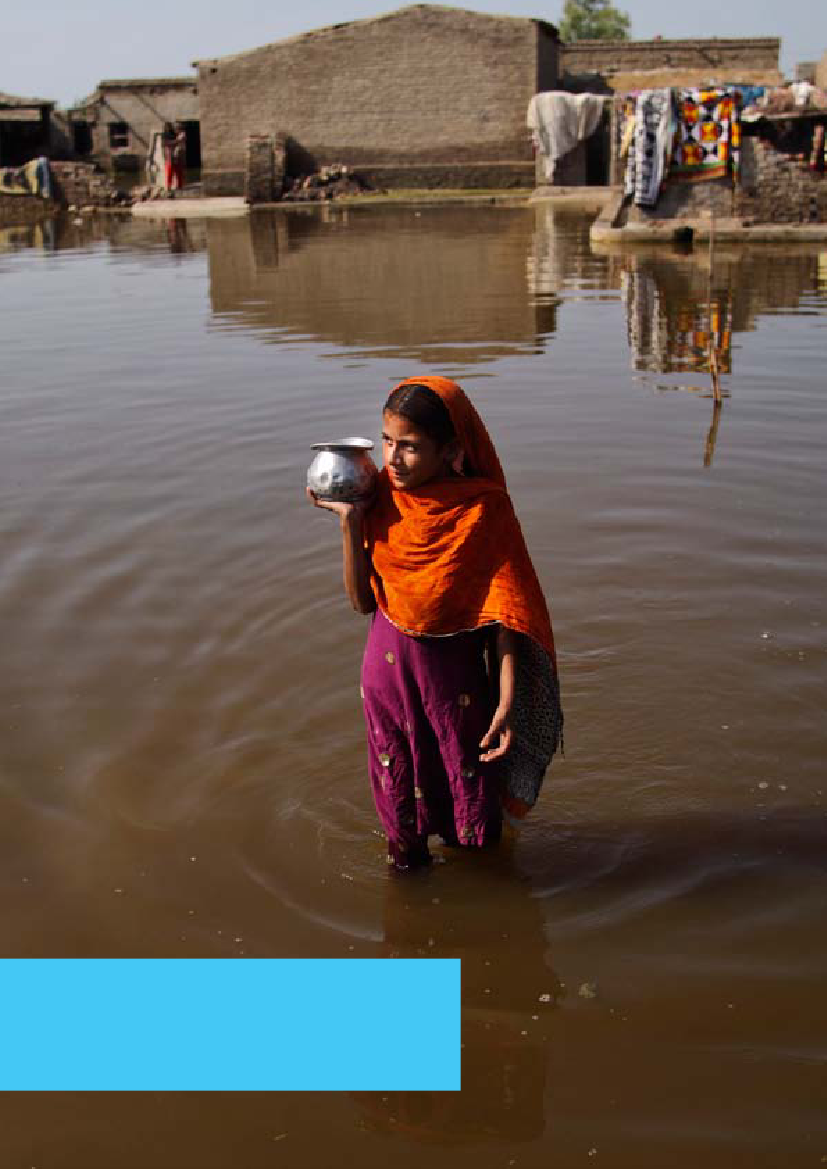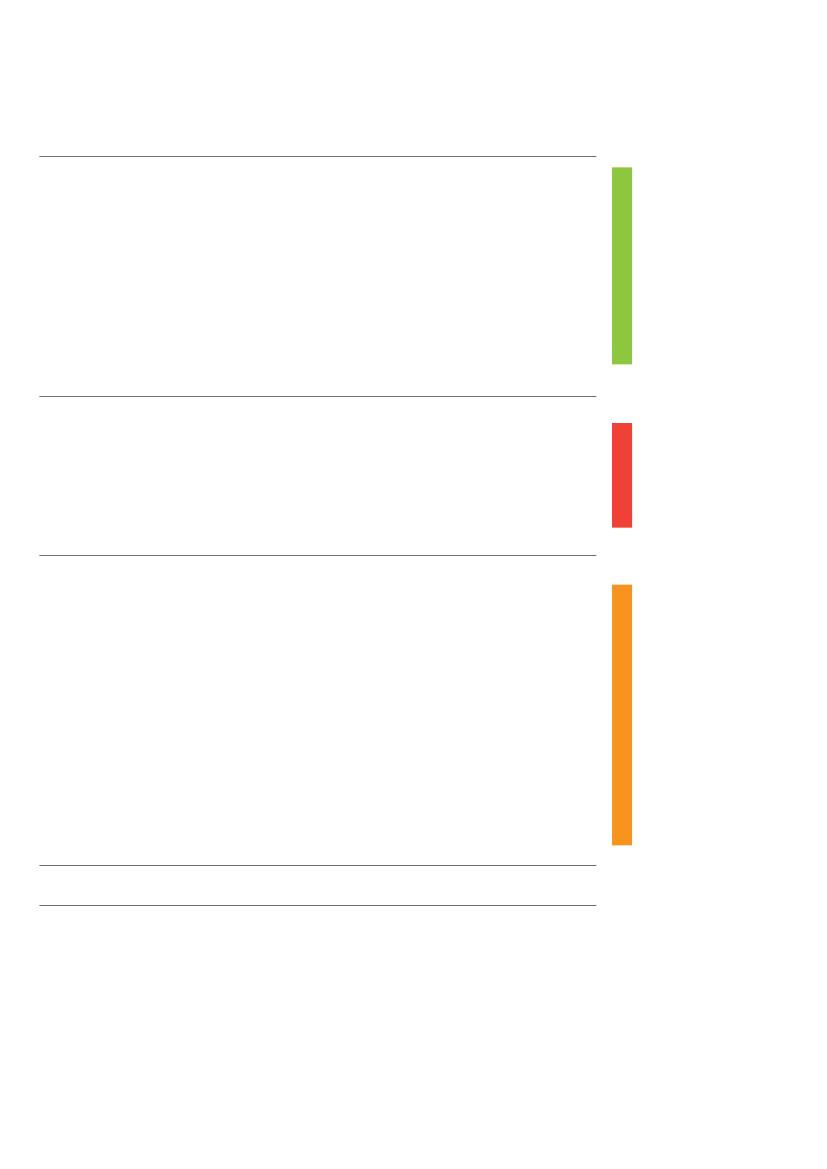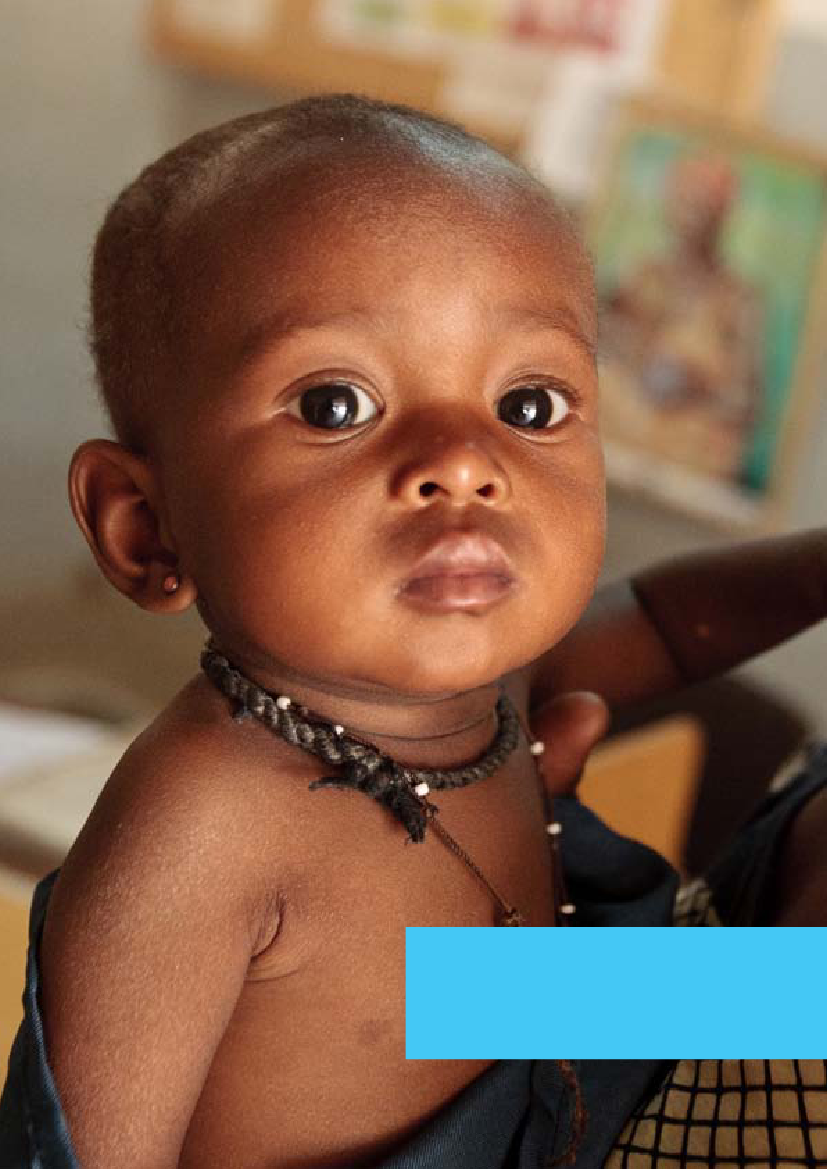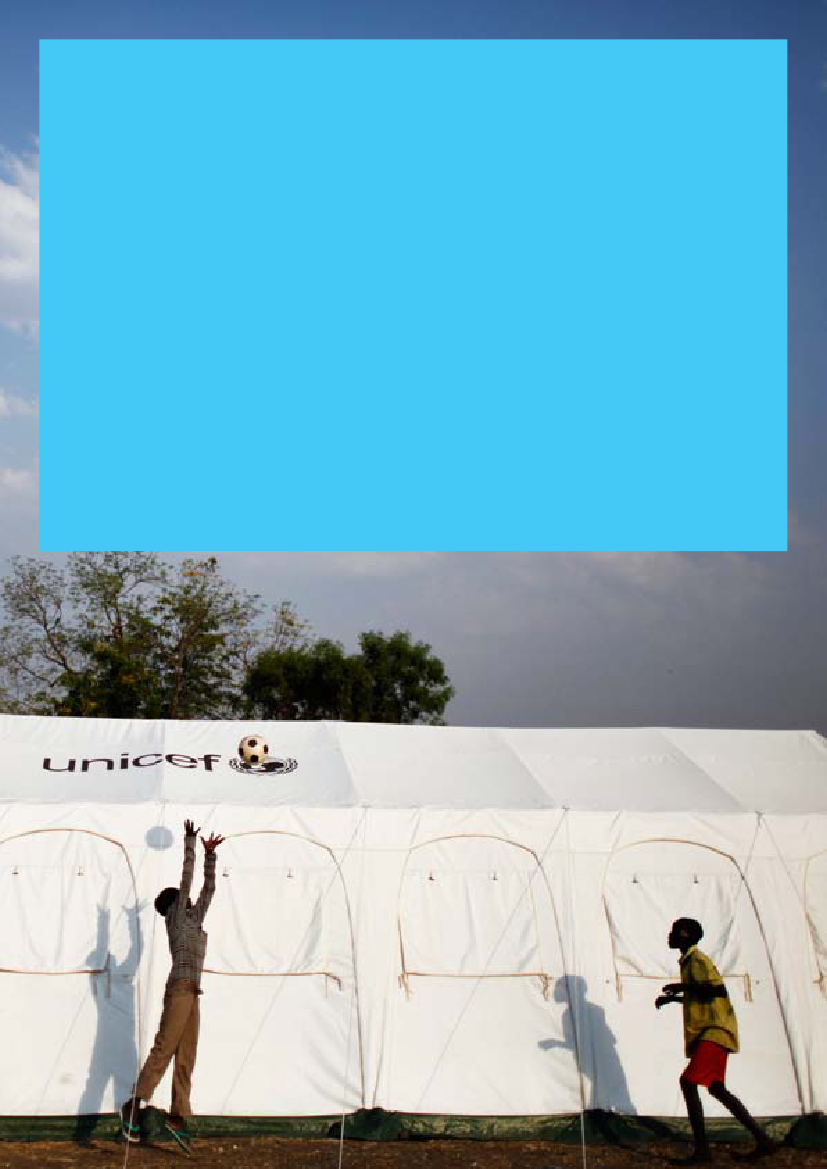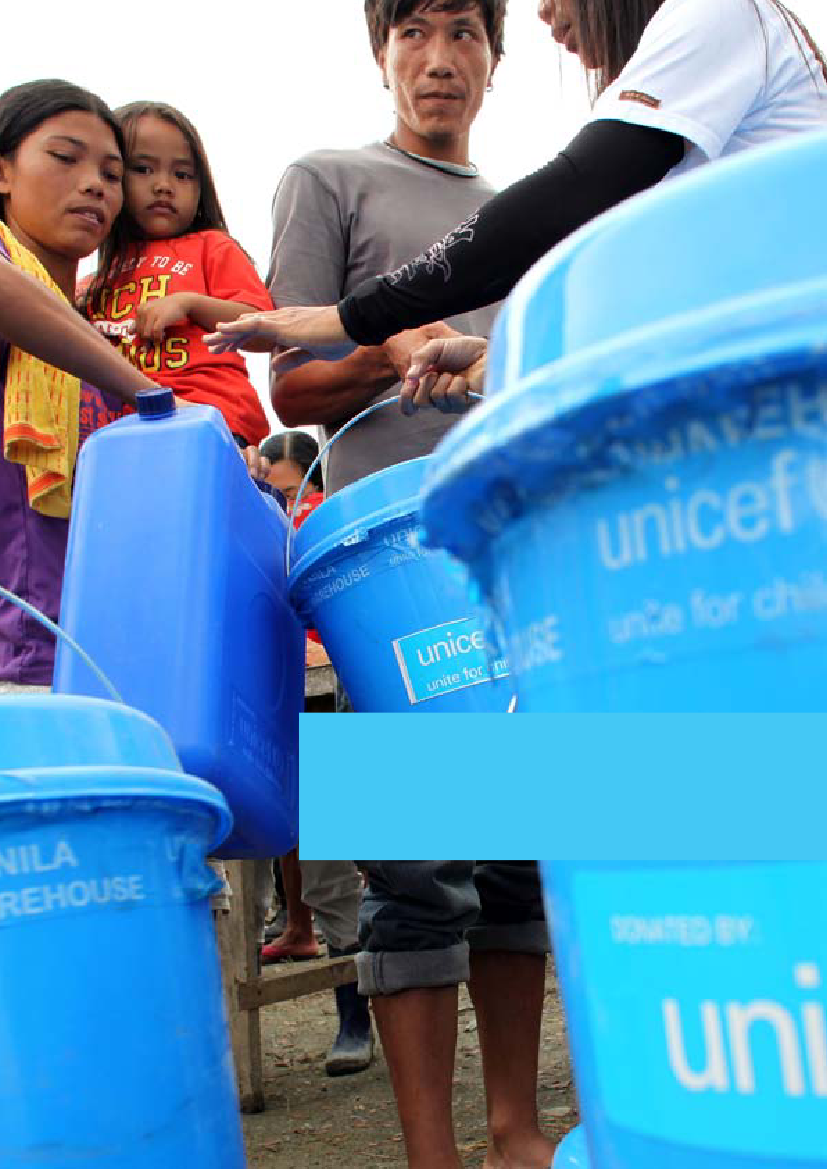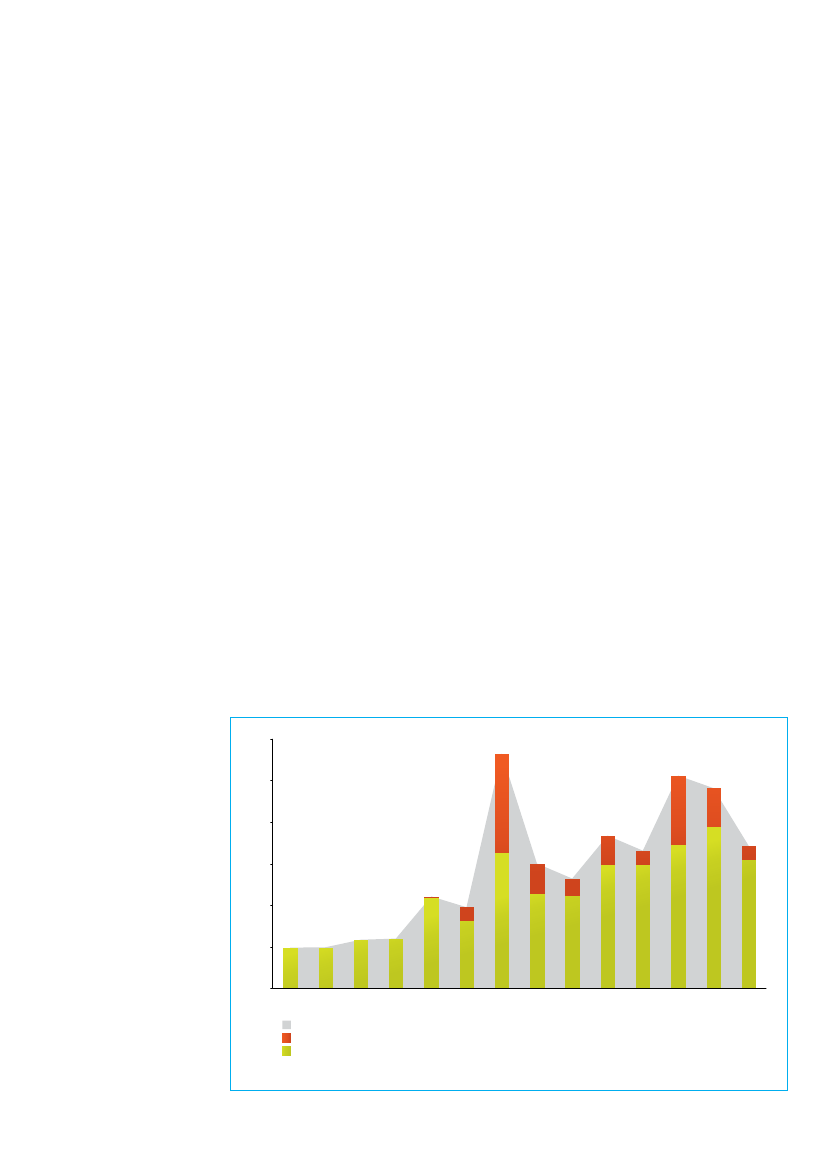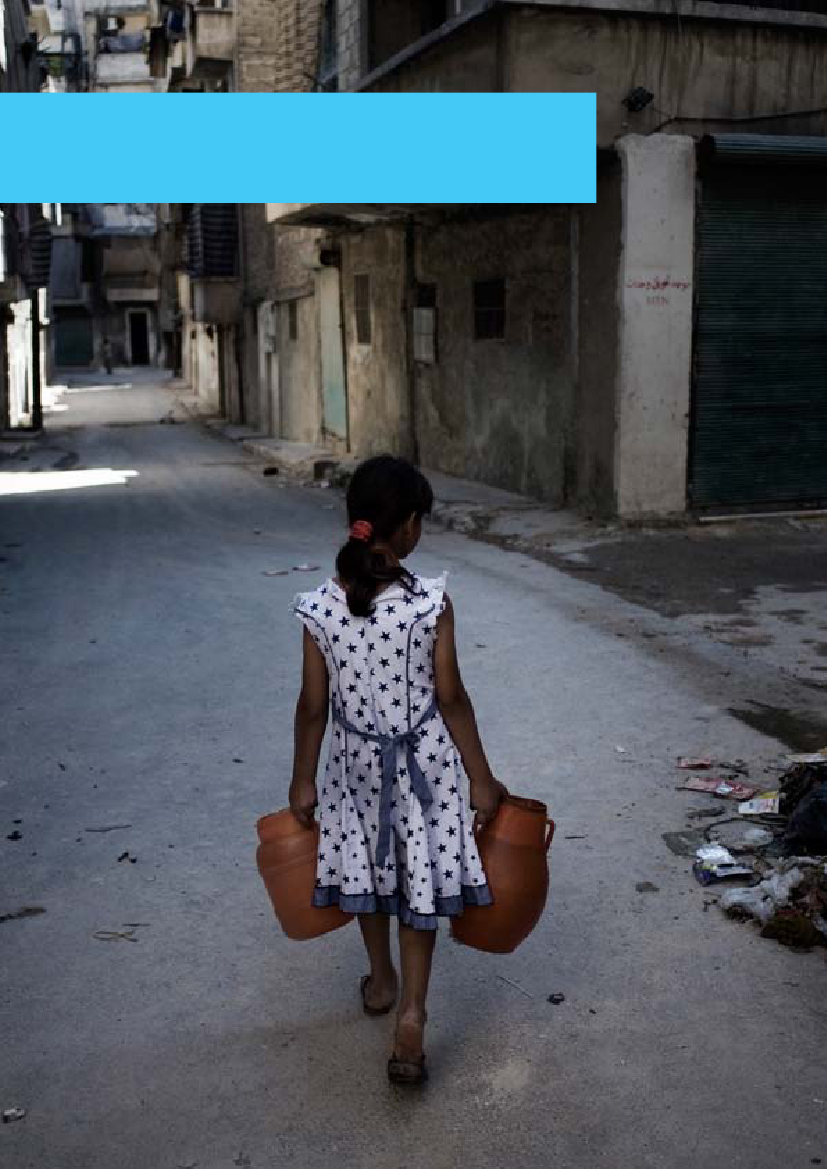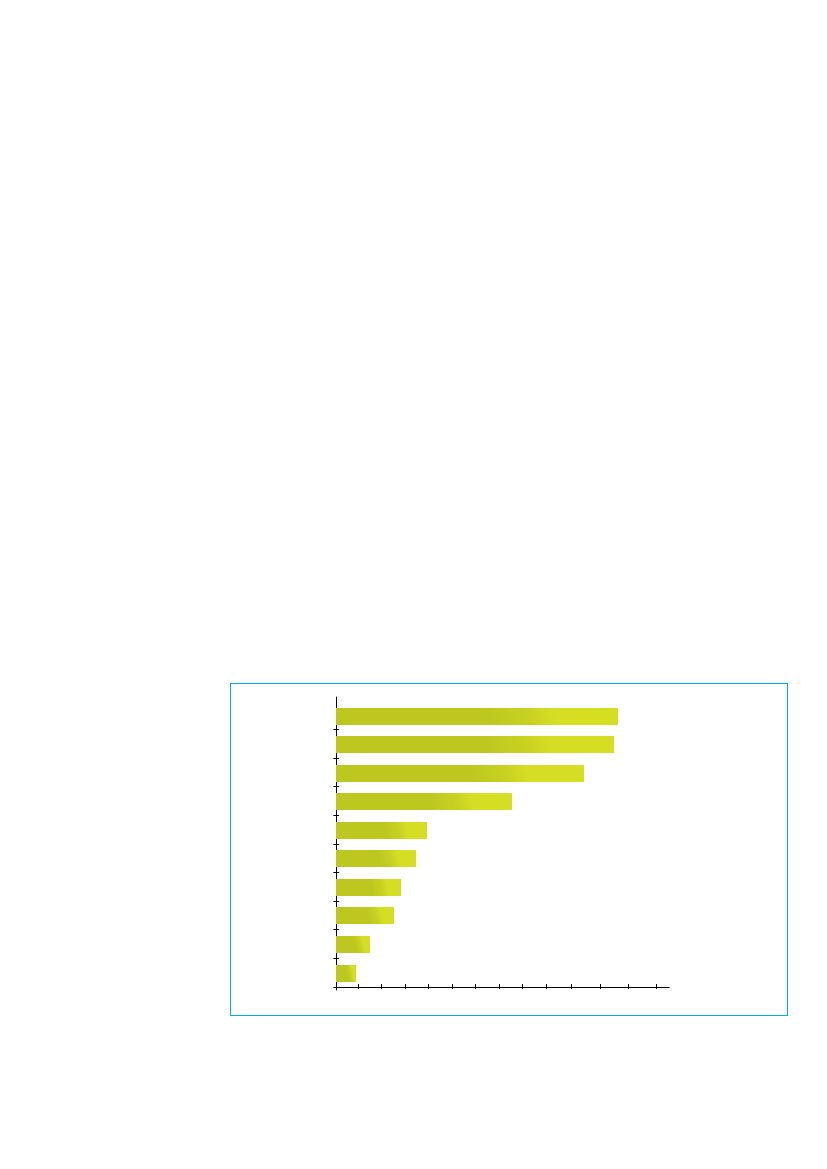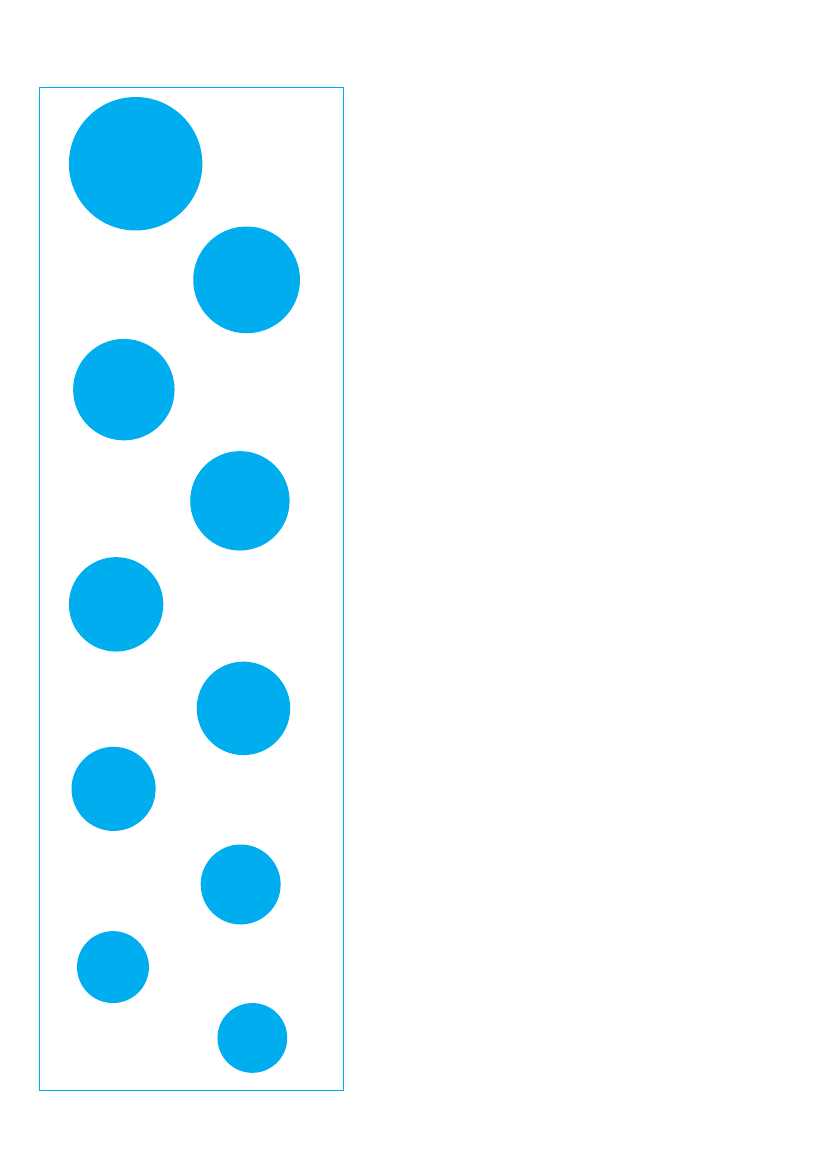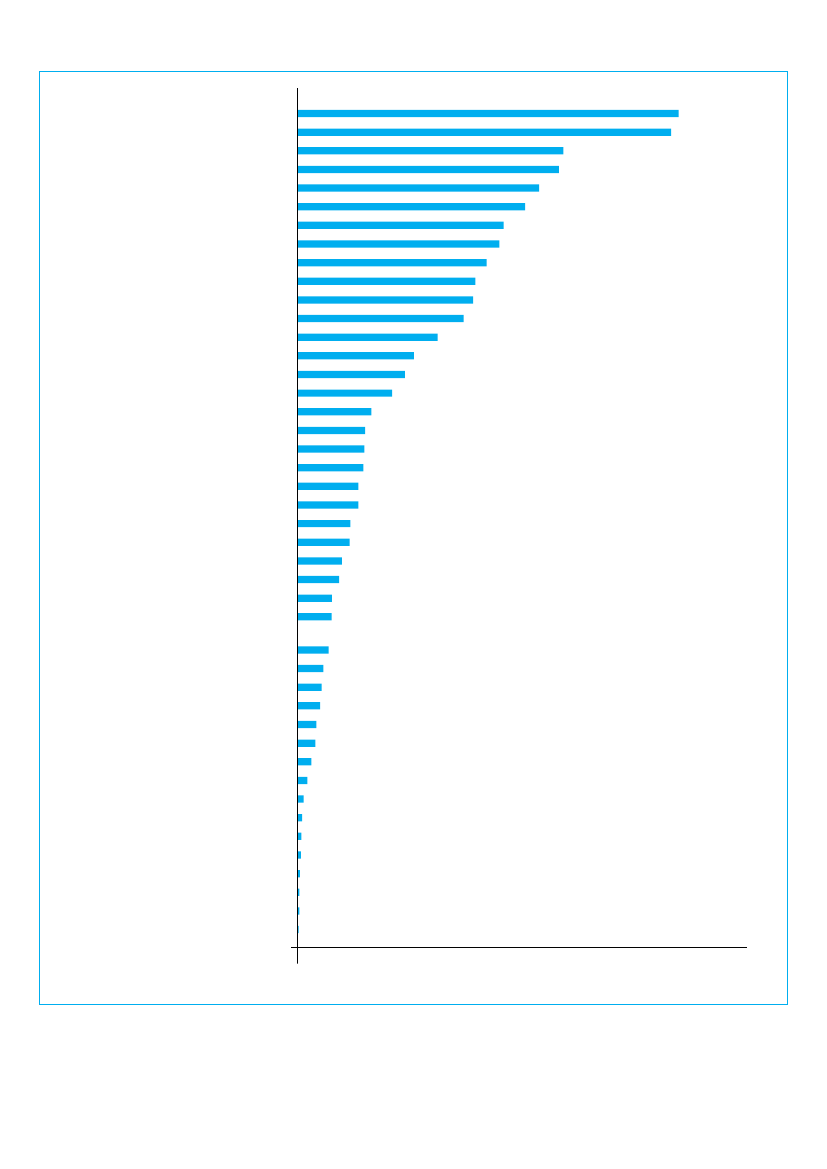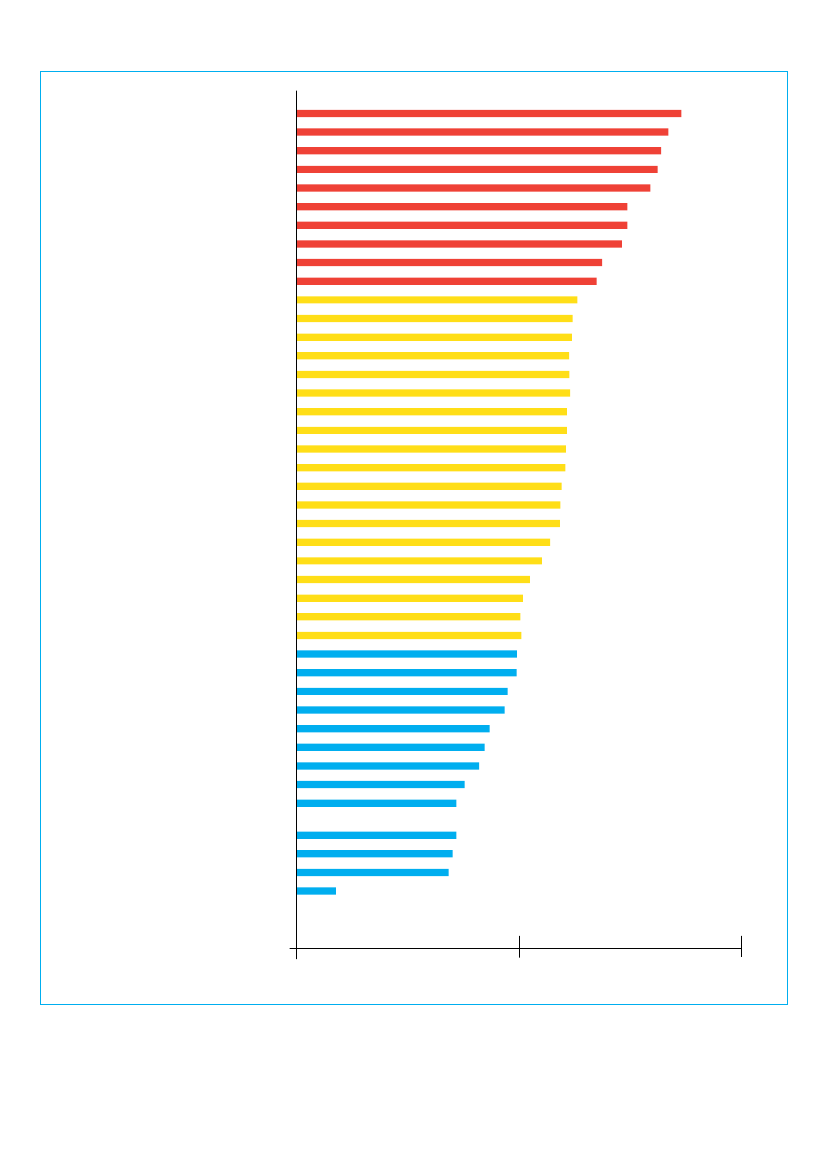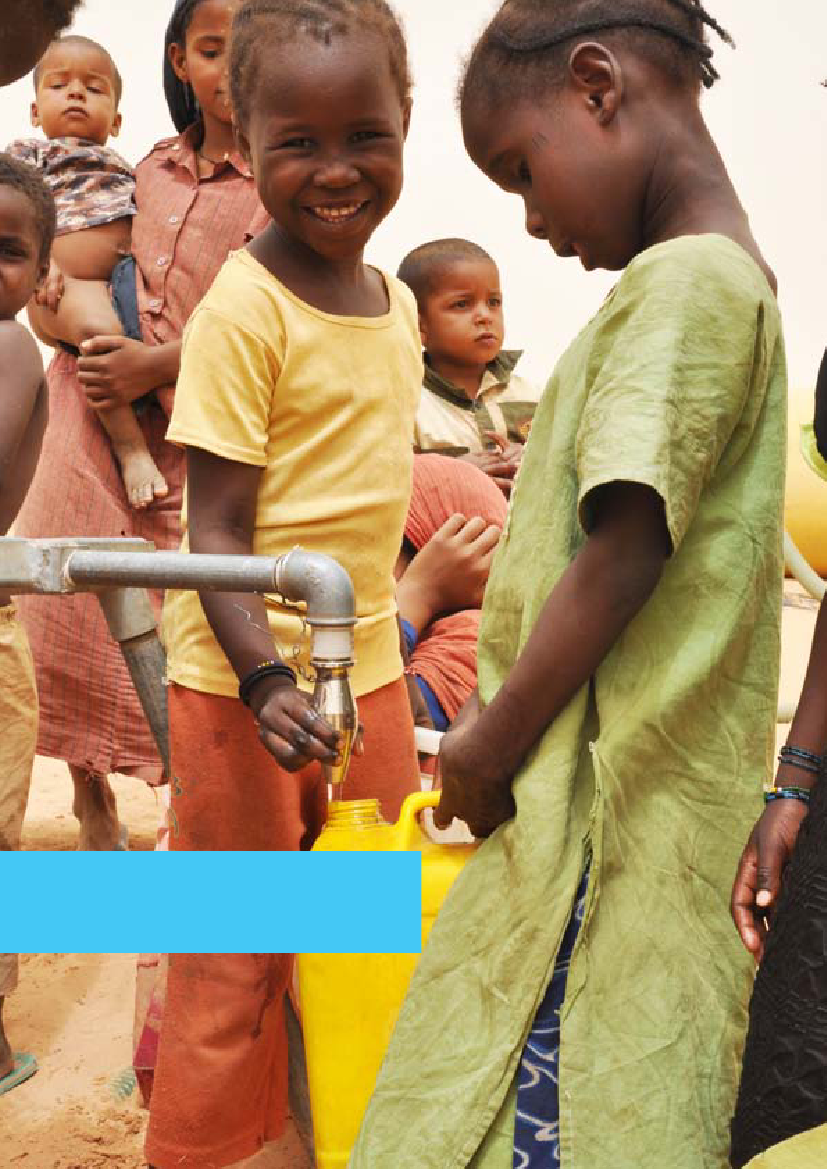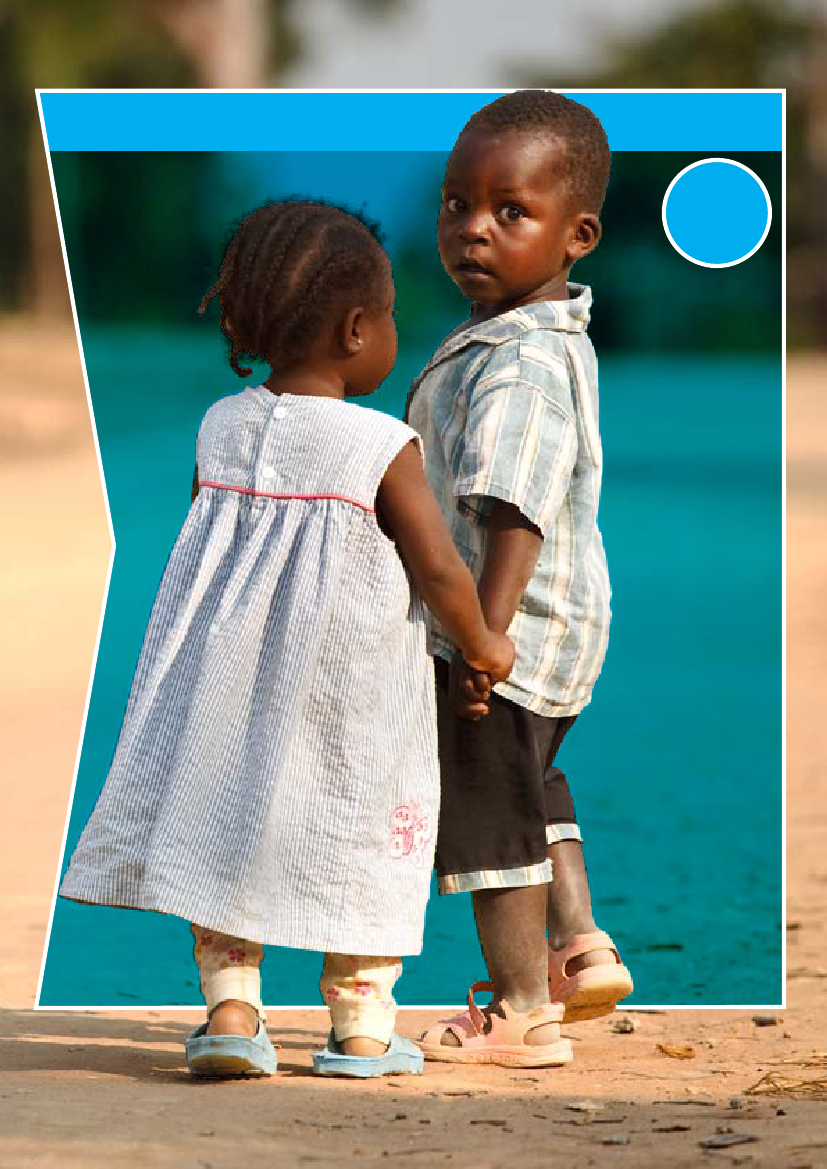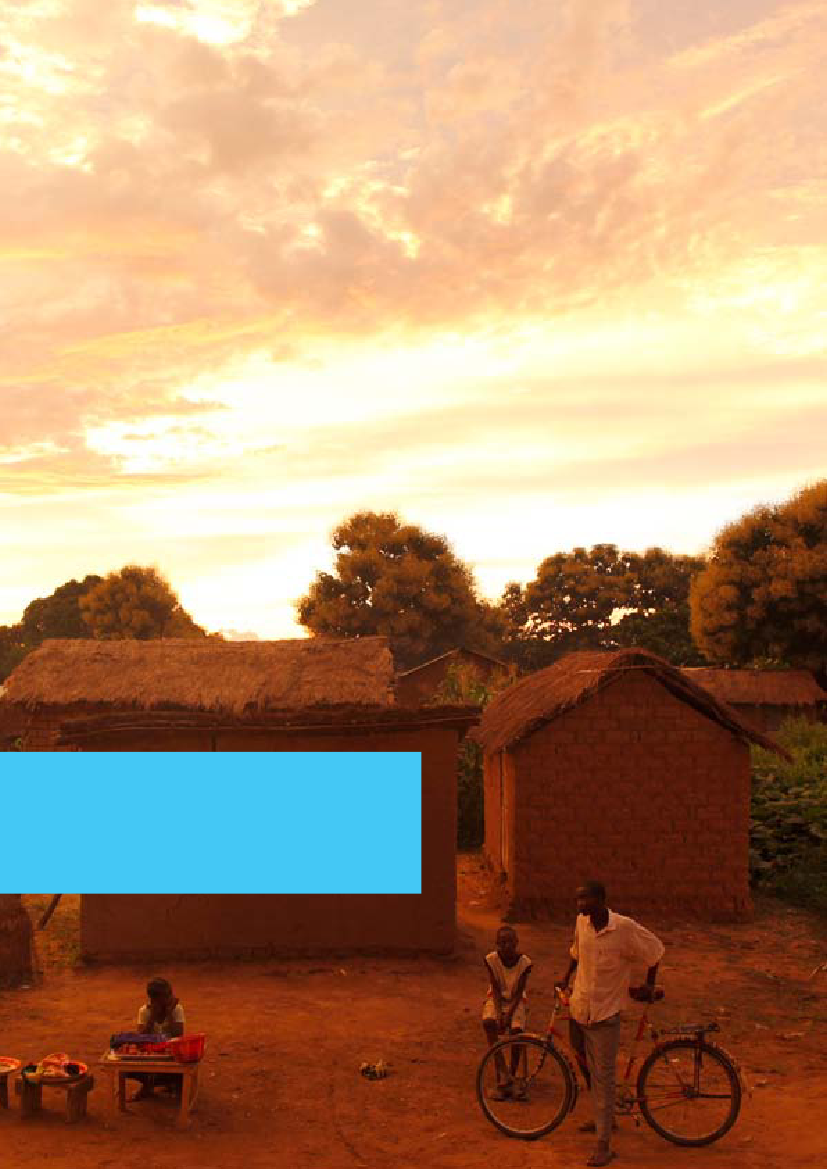Udenrigsudvalget 2012-13
URU Alm.del Bilag 82
Offentligt
UNICEFHumanitarian Actionfor Children2013Overview Document
unite forchildren
COVER PHOTO: JORDAN, 2012Children wash clothes, in Za’atari, a tented camp forSyrian refugees, on the outskirts of Mafraq, capital of thenorthern Mafraq Governorate. UNICEF assistance in thecamp includes the provision of safe drinking water and theinstallation of permanent latrines, bathing facilities, washbasins, as well as mobile units containing these amenities.� UNICEF/NYHQ2012-0867/Kate Brooks
� United Nations Children’s Fund (UNICEF)January 2013Permission to reproduce any part of this publication is required.Permission will be freely granted to educational or non-profitorganizations. Others will be required to pay a small fee.Please contact:Division of Communication, UNICEF3 United Nations PlazaNew York, NY 10017, USATel: + 1 (212) 326-7434Email: <[email protected]>This report and additional online content are available at<www.unicef.org/appeals>.ISBN: 978-92-806-4678-8
UNICEFHumanitarian Actionfor Children2013Overview Document
unite forchildren
AcknowledgementsThe Humanitarian Action for Children was made possible with the advice and contribution of many people from UNICEF country and regionaloffices and Headquarters. Information was received from the following offices: Afghanistan, Angola, Burkina Faso, Central African Republic,Chad, Colombia, Côte d’Ivoire, Djibouti, Democratic People’s Republic of Korea, Democratic Republic of the Congo, Egypt, Eritrea, Ethiopia,Georgia, Haiti, Iraq, Jordan, Kenya, Kyrgyzstan, Lebanon, Lesotho, Liberia, Madagascar, Mali, Mauritania, Myanmar, Niger, Pakistan,Philippines, Somalia, South Sudan, State of Palestine, Sudan, Syrian Arab Republic, Tajikistan, Turkey, Yemen and Zimbabwe as well asregional offices for Central and Eastern Europe and the Commonwealth of Independent States; East Asia and the Pacific; Eastern andSouthern Africa; Latin America and the Caribbean; Middle East and North Africa; South Asia; and West and Central Africa. Thanks also to allother colleagues and country offices that contributed, including through regional chapters.PROJECT MANAGEMENT, EDITORIAL AND RESEARCHAkhil Iyer,Deputy Director,Office of Emergency Programmes; Rafael Hermoso,Project Manager,Office of Emergency Programmes; NaomiIchikawa,Manager,Office of Emergency Programmes; Zuhal Ayoub,Researcher;Mari Denby,Reporting;Catherine Langevin-Falcon,Chief,Publications Section, Division of Communication; Samantha Mort,Senior Advisor Communications,Office of the Executive Director(Foreword); Hirut Gebre-Egziabher,Communication Specialist;Yasmine Hage and Lisa Kenney, fact-checking; Charlotte Maitre,Editor;KristinMoehlmann, Anna Grojec, copy-editing; Ellen Tolmie,Sr. Photography Editor;Lucy Braun,Communication Specialist.Thanks to the following UNICEF divisions: Office of Emergency Programmes, Programme Division, Public-Sector Alliances andResource Mobilization Office, Private Fundraising and Partnerships. Particular thanks also to Ted Chaiban,Director,Office ofEmergency Programmes; Darla Silva,Executive Manager,Office of the Executive Director; Nicholas Alipui,Director,ProgrammeDivision; June Kunugi,Director a.i.,Public Sector Alliances and Resource Mobilization; Leila Pakkala,Director,Private Fundraising andPartnerships; Khaled Mansour,Director,Division of Communication; Dermot Carty,Deputy Director,Office of EmergencyProgrammes; Christian Salazar,Deputy Director,Programme Division; Anna Azaryeva, Genevieve Boutin, Babita Bisht, Erin Boyd,Andrew Colin Parker, Silvia Danailov, Terry Davis, Lisa Doughten, Brendan Doyle, Faika Farzana, Francois Ducharme, Tsedeye Girma,Brenda Haiplik, James Hedges, Pernille Ironside, Sarah Karmin, Christine Knudsen, Sandra Lattouf, Gwyn Lewis, Michel Le Pechoux,Mendy Marsh, Reuben McCarthy, Nalinee Nippita, George Paltakis, Heather Papowitz, Stephane Pichette, Martin Porter, JalpaRatna, James Rogan, Guillaume Sauval, Oren Schlein, Saudamini Siegrist, Junko Toda, Jesus Trelles, and Julie Verhaar. Thanks alsoto UNICEF Regional Offices: Shameza Abdulla, Selassie Atadika, Laura Bill, Gianluca Buono, Antonello Castaldi, Luc Chauvin, MarkChoonoo, Seydou Dia, Andrea James, Grant Leaity, Tania McBride, Robert McCarthy, Heidi Peugeot, Asim Rehman, Magalie Salazar,Carmen van Heese, Bastien Vigneau, Toby Wicks, Lana Wreikat as well as all technical advisers.DESIGN AND PRE-PRESS PRODUCTIONJames Elrington,Design Specialist,Private Fundraising and PartnershipsMAPSJihad Abdalla,Emergency OfficerWEBSITE PRODUCTIONKeith Musselmann,Senior Project Manager;Dennis Yuen,Web Design and DevelopmentOUTREACHPeter Smerdon,Chief,Media Relations; Kent Page,Communication Specialist;Patrick McCormick,Communication Manager;Christopher Tidey,Communication SpecialistPRINTINGBrian Myers, Division of Finance and AdministrationTRANSLATIONFrench edition:French Committee for UNICEF.Spanish edition:Spanish Committee for UNICEFIncome and results through 31 October 2012
Further information on UNICEF’s humanitarian action can be obtained from:Ted ChaibanDirectorOffice of EmergencyProgrammes (EMOPS), UNICEF New YorkTel: +1 212 326-7163Fax: +1 212 326-7037Email: [email protected]June KunugiDirector a.i.Public Sector Alliances and ResourceMobilization (PARMO), UNICEF New YorkTel: +1 212 326 7009Fax: +1 212 326 7165Email: [email protected]Dermot CartyDeputy DirectorOffice of Emergency Programmes(EMOPS), UNICEF GenevaTel: + 41 22 909 5601Fax: + 41 22 909 5902Email: [email protected]
Contents
58111215162225
Executive Director’s foreword2013 funding requirementsSummaryThe humanitarian situationThe responseOverall funding trends2013 planned responseGlobal support
UNICEFHumanitarian Action for Children 2013 |3
Haiti
Maurita
Colombia
Liberia
Countries included in theHumanitarian Action for Children 2013The boundaries and names shown and the designations used on this map donot imply official endorsement or acceptance by the United Nations.Final boundary between the Republic of Sudan and the Republic of SouthSudan has not yet been determined.* Dotted line represents approximately the Line of Control in Jammu andKashmir agreed upon by India and Pakistan. The final status of Jammuand Kashmir has not yet been agreed upon by the parties.** ‘State of Palestine’ was designated for use in all official United Nationsdocuments as of 19 December 2012. It reflects General Assemblyresolution 67/19.� UNICEF/NYHQ2012-1269/Salah Malkawi
JORDAN, 2012UNICEF Executive DirectorAnthony Lake observeschildren in their newly openedschool, in Za’atari, a camp forSyrian refugees, on theoutskirts of Mafraq, capitalof the northern MafraqGovernorate.
4|UNICEFHumanitarian Action for Children 2013 –<www.unicef.org/appeals>
Georgia
KyrgyzstanTajikistan
Democratic People’sRepublic of Korea
Syrian Arab RepublicState of Palestine**Syrian refugees inEgypt, Iraq, Jordan,Lebanon and TurkeyMauritaniaMaliNiger
AfghanistanPakistan
Jammu andKashmir*
Myanmar
Burkina FasoCôteLiberia d’Ivoire
Eritrea YemenDjiboutiSouth EthiopiaCentral African SudanRepublicSomaliaKenyaDemocraticRepublic ofthe CongoChadAngolaZimbabweMadagascar
Sudan
Philippines
Lesotho
Executive Director’s ForewordHumanitarian Action for Children 2013At first glance, Fatima looked to be about 4 or 5months old. In fact, she had just passed her firstbirthday. She was among the 126,000 childrenwith severe acute malnutrition treated at oneof 425 nutrition rehabilitation centres set up byChad’s Ministry of Health in 2012 as part of aSahel-wide scale-up. Hundreds of thousandshave been reached with life-saving assistance.Sadly, many others have not.With each passing day, 14-month-old RababMohammed Saleh’s smile was becoming alittle wider; her body growing a little stronger.She was at the therapeutic feeding centre ofAl-Sabaeen Hospital in Sana’a, Yemen beingtreated for malnutrition. Rabab lives with hersingle mother and 10 surviving siblings.Four have died. In Yemen, almost 1 millionchildren are acutely malnourished; over aquarter of a million suffer from severe acutemalnutrition and live, daily, in the shadowof death.At the sprawling Za’atari refugee camp near theborder between Jordan and the Syrian ArabRepublic, 12-year-old Tabark had resumedclasses at the new emergency school. Herdream is to become an Arabic teacher. Over47,000 refugee children in neighbouringcountries and 23,000 children inside the SyrianArab Republic have benefited from emergencyeducation programmes, while initiatives to
UNICEFHumanitarian Action for Children 2013 |5
protect their psychological wellbeing havereached 32,000 children inside the Syrian ArabRepublic and 42,000 in neighbouring countries.For too many children, though, education andprotection become casualties of crisis.These are just some of the hundreds ofcourageous children I have met during field tripsin the last 12 months.Humanitarian Action for Children 2013highlights the challenges children such asFatima, Rabab and Tabark face in humanitariansituations around the world. It identifies thesupport required to help these childrensurvive and thrive. Most importantly, it showsthe results our partners and we have achieved,and must strive to achieve, for children in need.For example, in 2012 in partnership with nationalgovernments, civil society organizations andother United Nations agencies, UNICEF wasprojected to treat 850,000 of the estimated1.1 million children under 5 with severe acutemalnutrition across the Sahel, even as theconflict in Mali deteriorated and prompted arefugee crisis in surrounding countries.Increasingly, we try to do so with a ‘resiliencereflex’, in ways that build the capacity of healthcentres and strengthen communities andfamilies for the future. Meanwhile, in Pakistan,109,000 children and women affected byflooding and insecurity were able to accessprotection, rehabilitative and recreationservices, as well as life-skills education, throughProtective Learning and Community EmergencyServices (PLaCES).Humanitarian response is no less important inthose parts of the world that do not commandmedia attention. In the Blue Nile and SouthKordofan states of Sudan, conflict has drivenover 210,000 people, over half of whom arechildren, across the borders into neighbouringSouth Sudan and Ethiopia, while an estimated695,000 people have been internally displacedor severely affected. In the DemocraticRepublic of the Congo, where 2.4 million peopleare displaced, the number of severelymalnourished children tops 1 million.Globally, we continue to improve our ability torespond to humanitarian emergencies. Wehave established new standard operatingprocedures to guide UNICEF’s efforts in theevent of large-scale emergencies, as well asprocesses to better meet our cluster andsector coordination responsibilities in thebroader humanitarian system. And we have6|UNICEFHumanitarian Action for Children 2013 –<www.unicef.org/appeals>
supported development of the TransformativeAgenda within the Inter-Agency StandingCommittee.As we strive to deliver better results for thosein desperate need, we are also mindful of theimportance of measuring those results andidentifying bottlenecks to greater progress.These results are made possible throughgenerous contributions from donors whocontinue to support UNICEF’s humanitarianaction even in times of fiscal austerity.Predictable and flexible funding supportsprogrammes like the ones described aboveand enables us to act quickly wherever andwhenever crises occur.We can deliver results for children in challengingenvironments and complicated emergencies.Fatima can recover from severe acutemalnutrition; Rabab’s health will improve; Tabarkcan continue her schooling. Together, we cangive all children in humanitarian situations thetools not only to recover but to realize theirpotential, nurture their talents and contribute tothe growth of their nations.
Anthony LakeUNICEF Executive Director
� UNICEF/NYHQ2012-1318/Asad Zaidi
PAKISTAN, 2012Fahimada, 8, carries a small container of water throughflood water back to her tent shelter, in Ranjhapur Villagein Jacobabad District in Sindh Province. She collected thewater from a nearby handpump.
UNICEFHumanitarian Action for Children 2013 |7
UNICEF humanitarian action fundingrequirements for 2013REGION/COUNTRYCENTRAL AND EASTERN EUROPE AND THECOMMONWEALTH OF INDEPENDENT STATESCentral and Eastern Europe and the Commonwealth ofIndependent States Regional OfficeGeorgiaKyrgyzstanTajikistanTOTAL2,500,0002,310,0001,540,0001,872,5008,222,500FUNDING REQUIREMENTS FOR 2013 (US$)
EAST ASIA AND THE PACIFIC REGIONALEast Asia and the Pacific Regional OfficeDemocratic People’s Republic of KoreaMyanmarPhilippinesTOTAL4,252,00022,790,0006,158,00023,609,00056,809,000
EASTERN AND SOUTHERN AFRICAEastern and Southern Africa Regional OfficeAngolaEritreaEthiopiaKenyaLesothoMadagascarSomaliaSouth SudanZimbabweTOTAL20,888,1505,300,00012,200,00049,487,00039,860,0357,563,94914,980,000140,961,02388,427,9624,590,000384,258,119
LATIN AMERICA AND THE CARIBBEANThe Americas and Caribbean Regional OfficeColombiaHaitiTOTAL1,600,0005,000,00011,650,00018,250,000
8|UNICEFHumanitarian Action for Children 2013 –<www.unicef.org/appeals>
REGION/COUNTRYMIDDLE EAST AND NORTH AFRICAMiddle East and North Africa Regional OfficeDjiboutiState of PalestineSudanSyrian Arab Republic
FUNDING REQUIREMENTS FOR 2013 (US$)
15,500,0007,980,00017,280,00071,335,68161,400,000140,700,00081,333,795395,529,476
Syrian refugees (Jordan, Lebanon, Iraq, Turkey and Egypt)YemenTOTAL
SOUTH ASIARegional Office for South AsiaAfghanistanPakistanTOTAL4,910,00027,045,00064,950,00096,905,000
WEST AND CENTRAL AFRICAWest and Central Africa Regional OfficeBurkina FasoCentral African RepublicChadCôte d’IvoireDemocratic Republic of the CongoLiberiaMaliMauritaniaNigerTOTALGLOBAL SUPPORTGRAND TOTAL30,250,00022,226,48511,516,94560,895,59116,470,000134,560,00016,016,50081,999,26318,885,93733,790,767426,611,4887,501,0191,394,086,602
UNICEFHumanitarian Action for Children 2013 |9
� UNICEF/NYHQ2012-0356/Oliver Asselin
BURKINA FASO, 2012Ramatou Tankouanou holds her malnourished daughter,7-month-old Saamatou Bangou, during a growth-monitoringsession at the health centre in Sector 1, a division of FadaN’gourma, capital of Est Region.
10|UNICEFHumanitarian Action for Children 2013 –<www.unicef.org/appeals>
SummaryUNICEF’sHumanitarian Action for Children 2013highlights the humanitarian situationfaced by millions of children and women and the support required to help their families,communities and national institutions meet their basic needs, promote their well-beingand provide them with protection.UNICEF is appealing for almost US$1.4 billion toassist millions of children, women and men byproviding them with nutritional support, healthcare, water, sanitation, learning spaces andmaterials, protection services, shelter andinformation. This support is not only to providelifesaving emergency interventions, but alsoto strengthen national preparedness systemsand build resilience at community, subregionaland national levels, so that avoidable illnessesand deaths are prevented and those affectedare able to recover. In partnership with nationalgovernments, civil society organizations andother United Nations agencies, UNICEF works insome of the most challenging environments inthe world to deliver results for millions ofchildren and women threatened by naturaldisasters or complex emergencies. Despitechallenges and constraints, sustained advocacy,political and financial commitment, andcollaboration in 2012 resulted in achievementsthat need to be built upon and continuedinto 2013.The past year saw the combined and cumulativeeffects of armed conflict, civil and politicalunrest, erratic and severe weather patterns,seismic activity, disease outbreaks and theglobal economic crisis lead to the death, illness,deprivation, displacement and distress of asignificant number of children, women and menacross the globe.The same factors caused the destruction orfurther degradation of homes, hospitals,schools, roads and other public and socialinfrastructure, services and networks,preventing millions of children from receivingtreatment for illness, drinking safe water, goingto school or even playing. Some children wereseparated from their primary caregivers, whileothers fled, unaccompanied, to saferlocations. Meanwhile many others wererecruited by armed groups as soldiers andlabourers. Whether affected by disasters orconflict, they suffered psychological and socialdistress in addition to physical suffering andharm. All too often, these new disasters andconflicts occurred in areas already battered byUNICEFHumanitarian Action for Children 2013 |11successive economic, climatic, political andother security shocks, severely compromisingthe ability of caregivers to feed and protect theirchildren, and fulfil their basic needs.In order to prevent, address or overcome someof the consequences of these natural andhuman-made disasters in 2012, UNICEF initiallyappealed for US$1,284,358,000. During thecourse of the year, as new crises occurred andongoing situations deteriorated or improved,the overall requirements were revised, and bythe end of October had increased by 14 percent to US$1,472,172,823. As of 31 October,US$664,475,807, or 45 per cent of the requiredfunds, had been mobilized. In addition, UNICEFreceived US$19,573,247 from the CentralEmergency Response Fund (CERF) and otherfunding sources to address the unforeseenneeds for countries that were not part of theHumanitarian Action for Children 2012,appeal, bringing the total of funding mobilizedto US$684,049,044.
For more information on individualcountry and regional appeals, andfor updates, go to<www.unicef.org/appeals>.
The humanitarian situationA range of natural disasters and conflicts continued to impact children’s vulnerability inmany countries in 2012, from nutrition crises across Africa, to the complex emergency inthe Syrian Arab Republic, to chronic humanitarian situations across the globe.Storms, floods and persistent droughtsexacerbated food insecurity in some areas,causing loss of life, livelihoods and property andthreatening children’s right to education andprotection. Targeted or indiscriminate violence –including sexual violence, abuse andexploitation – not only led to new or continuedmass displacements within and across borders,but also left millions of others stranded ininsecure and isolated locations, with little or noaccess to food, basic social services orhumanitarian assistance. The outbreak orcontinued spread of infectious diseases affectedall countries facing disasters, both natural andhuman-made.The internal armed conflict in the Syrian ArabRepublic is in its second year and has affected2.5 million people, displacing 1.2 millioninternally and nearly 400,000 more acrossborders into Iraq, Jordan, Lebanon, Turkey andEgypt. Countless homes, schools, hospitals andother essential infrastructure such as water andsanitation (WASH) systems have been eitherdestroyed or severely damaged.Meanwhile, food and nutrition crises againimpacted millions of children. In the Horn ofAfrica and across the Sahel belt of West andCentral Africa, an estimated 1.1 million childrenunder 5 were at risk of severe acute malnutrition,and in Southern Africa, more than 6 millionpeople were affected in Angola, Lesotho, Malawiand Zimbabwe. Food insecurity is chronic inmany parts of Africa, allowing shocks to tiltvulnerable populations into crisis, and reinforcingthe importance of strengthening communityresilience. The concerted response to foodinsecurity in the Horn of Africa reduced thenumber of people in need of food assistancefrom 3.75 million to 2.1 million in Kenya and by50 per cent in Somalia, though persistent failuresin rainfall patterns have slightly increased thenumber of people needing food aid in Ethiopia.Undernutrition also remained a part of daily life inother parts of the world, including the DemocraticPeople’s Republic of Korea.And again in 2012, food crises were magnifiedby conflict. Armed conflict coupled with foodinsecurity in northern Mali affected more than12|UNICEFHumanitarian Action for Children 2013 –<www.unicef.org/appeals>2.8 million people, including internally displacedpersons and host populations, and caused aregional refugee crisis, creating additionalburdens for vulnerable communities in BurkinaFaso, Mauritania and Niger already affected by afood and nutrition crisis resulting fromrecurrent drought and food insecurity inthe Sahel.Continued and intensified conflicts also affectedand displaced millions in Afghanistan, theCentral African Republic, Colombia, theDemocratic Republic of the Congo, Pakistan,Somalia, the State of Palestine, Sudan andYemen, leading to internal displacement or theoutflow of new refugees into neighbouringcountries. Inter-communal violence erupted inMyanmar and South Sudan, leading to internaldisplacements. Peace talks and new peacedeals forged in 2012 are yet to translate into realchange for people in Colombia, Myanmar andthe Philippines.In many places, communities had to cope withmultiple or repeated shocks, such as continueddisplacement and humanitarian needs in Côted’Ivoire and Liberia; a third straight year ofsignificant flooding in Pakistan; and diseaseoutbreaks atop nutrition crises and conflict in theSahel. At the same time, multiple naturaldisasters such as floods, landslides andearthquakes, coupled with extremely coldtemperatures, affected several communities inthe region of Abkhazia in Georgia and inKyrgyzstan and Tajikistan, increasing the numberof food-insecure households and their level ofvulnerability in areas already disadvantaged byisolation, low governance capacity and poorbasic social service systems.And as 2012 closed, humanitarian situationsintensified in many parts of the world. In theDemocratic Republic of the Congo, the numberof people internally displaced by fightingcontinued to rise. Communities in the Stateof Palestine were again recovering followingviolence in the Gaza Strip in November. And theMindanao region of the Philippines was nowresponding to additional needs followingTyphoon Bopha in early December.
Results for ChildrenIn partnership with national governments, civil societyorganizations and other United Nations agencies, UNICEFhas long worked to deliver results for children and women inhumanitarian situations. Each year, the challenges faced bychildren in these contexts, and the support required to helpthem survive and thrive, have been presented in UNICEF’sHumanitarian Action for Childrenfunding document.This year, theHumanitarian Action for Children 2013document goes a step further and also reflects recentincreased efforts to make UNICEF’s humanitarian actionmore strategic and results-based. Individual country chapterspresent achievements1from past contributions2against settargets and, where relevant, within cluster- or sector-wideresults. Funding requirements are also presented againstclear targets to the extent possible, based on internationalstandards and UNICEF’s Core Commitments for Children inHumanitarian Action.The work to make UNICEF’s appeals and reporting moreresults-based is in line with similar efforts to strengthenmonitoring throughout the broader humanitarian system toUNICEF and its partners will continue to strengthen systemsto be more results-based, to articulate humanitarian appealsbased on needs, standards and targets, and to show whatresults have been achieved for children and women.which UNICEF contributes. The organization has been a keycontributor to this area through the Inter-Agency StandingCommittee’s Transformative Agenda – the ongoing effort ofhumanitarian partners to advance humanitarian reform.
PHOTO: SOUTH SUDAN, 2012Two boys who have been displaced by inter-ethnic violenceplay with a football, outside a UNICEF-supportedchild-friendly space that is housed in a tent, in Pibor Town,Pibor County, Jonglei State. The space provides recreationalactivities for over 200 children, serves as a temporarylearning centre and also offers psychosocial support.
� UNICEF/NYHQ2012-0148/Brian Sokol
UNICEFHumanitarian Action for Children 2013 |13
PHILIPPINES, 2012People affected by Typhoon Bopha receive family hygiene kits andjerrycans at an aid distribution site in the flood-ravaged town of New Bataan,in Compostela Valley Province in Davao Region in south-eastern Mindanao.UNICEF and partners are distributing family hygiene kits and other reliefsupplies.
� UNICEF/NYHQ2012-1706/Josh Estey
14|UNICEFHumanitarian Action for Children 2013 –<www.unicef.org/appeals>
The responseUNICEF worked with partners in support of hostgovernments and civil society to provide resultsfor children and women through the delivery ofprogrammes in nutrition; health; water, sanitationand hygiene (WASH); child protection; education;and HIV and AIDS. In many countries, UNICEFwas also responsible for leading or co-leadingclusters and areas of responsibility for nutrition;WASH; education; child protection; andgender-based violence.Prominent among the results through October2012 was the treatment of malnutrition (2 millionchildren treated), including more than 700,000severely malnourished who were reached as partof a Sahel-wide scale-up. Achievements alsoincluded the provision of vaccinations(38.3 million immunized), micronutrients andsafe drinking water (12.4 million people providedwith access to safe water for drinking, cookingand bathing); and basic child protection services(reaching 2.4 million children with a variety ofservices). Some 3 million children were providedwith access to improved education, includingthrough temporary spaces, and 1 million peoplewere provided with access to HIV and AIDStesting, counselling and referral for treatment.Children and women were reached throughinnovative approaches, such as the continuedexpansion of community-based interventions andimproved coordination and collaboration amongpartners and sectors. Increased efforts tomobilize and train community members indetecting and referring malnutrition and childprotection cases enabled more children to betreated and more child protection cases to beaddressed. Where crises affected severalcountries, or spilled over into neighbouringstates, cross-border strategies and subregionalmechanisms were increasingly used, such as theapproach to the three major cross-border choleraoutbreaks in West and Central Africa. Additionalresults were possible through the use ofpre-positioned stocks, which enabled somecountry offices to respond to emergencies in atimely manner, while in others, Colombia andMadagascar, for example, some of theemergency needs were met by the re-allocationof funds from regular programme resources.Closer partnerships and improved cohesion inprogramme planning, implementation andmonitoring between sectors, coordination groupsand organizations led to increased efficiency andto better and more timely delivery of services.This was increasingly evident between theWASH and nutrition sectors in the Sahel;between WASH and health sectors in theresponse to cholera, including in Haiti; betweenWASH and education in providing toilets inschools; and in the provision of health,WASH and education services to childprotection centres.But humanitarian responses also faced significantconstraints. Scarce resources meant prioritizingsome sectors and services over others,compromising the ability to address child rightscomprehensively. Sanitation services, hygienepromotion, improved education, health-careservices and the launching of informationcampaigns to prevent HIV and AIDS or landmineinjuries were severely compromised, with lackof funding given as the main, but not the only,constraint. People’s ability to access humanitarianassistance was also hampered or denied,prevented at times by insecurity and at times bythe physical challenges of poor infrastructure.Some of these challenges were alsocompounded by insufficient national andinternational commitment and political will. Weakimplementation capacity and a lack of resourcesfor local and international partners alsocompromised the ability to scale up effectivelyand adequately in some cases.
UNICEF response in 2012included the followingresults:3
NUTRITION2 million childrenweretreated for severe andmoderate malnutrition
HEALTH38.3 million childrenwereimmunized
WATER, SANITATION& HYGIENE12.4 million peoplewereprovided with access tosafe water for drinking,cooking and bathing
CHILD PROTECTION2.4 million childrenwereprovided with childprotection services
EDUCATION3 million childrenwereprovided with access toimproved education,including throughtemporary spaces
HIV and AIDS1 millionwere providedwith access to testing,counselling and referralfor treatment
UNICEFHumanitarian Action for Children 2013 |15
Overall funding trendsIn 2012, humanitarian funding followed patterns similar to those of prior years, with themajority of income concentrated in a few high-profile emergencies, some encompassingseveral countries.In 2012, UNICEF’s funding requirements forhumanitarian action totalled almost US$1.5billion. This included the requirements presentedin the 43 country, regional and headquartersoffices outlined inHumanitarian Action forChildren 2012,in addition to one inter-agencyflash appeal.As of 31 October, UNICEF had mobilized US$664million against total appeal requirements fromvarious donor governments, private institutionsand individuals. An additional US$19 million out-side these appeals from CERF and other fundingsources4brought the provisional humanitarianincome to US$684 million. Although overall, theproportion of funds received compared to theamount requested was, at 45 per cent, relativelylow, the proportion varied significantly fromcountry to country, with some receiving morethan the requested amount, half receiving lessthan 40 per cent and some receiving less than10 per cent. Funding varied not only betweencountries, but also between sectors, forcingmany components of a comprehensiveresponse to the needs of children and womento go unfunded.Again, much of the humanitarian contributionswent to addressing the food and nutrition crisesin Africa. Nearly 40 per cent of 2012 humanitarianfunding was contributed to the Sahel crisis (US$146million across nine countries and the regional office)and the Horn of Africa response (US$125 million),with the remaining 60 per cent directed towardsUNICEF’s other emergency operations.The initialHumanitarian Action for Children2012had a budget of almost US$1.3 billion thatwas later revised to almost US$1.5 billion. Asshown in Figure 1.5, only Niger and the Stateof Palestine were fully funded in 2012. Mostcountries experienced funding shortfalls, withhalf of offices receiving less than 40 per centof requirements. UNICEF country offices inMadagascar and Sri Lanka and regional officesfor East Asia and the Pacific and Latin Americaand the Caribbean each received less than 10 percent of their humanitarian funding requirements.In some cases, where funds were available, as inAfghanistan, their late receipt severely curtailedimplementation time. And where limited fundingwas overcome to reach children and women, theassistance was not always sustainable. Forexample, in education and child protection, most
FigureEmergency Funding Trend, 1999 – 20121999–20121.1: Emergency funding trend,1,200
1,1291,023
1,000
963
800601600443400235197200199240391529
735663684
0
1999
2000
2001
2002
2003
2004
2005
2006
2007
2008
2009
2010
2011
2012*
All Emergency TrendsThematic (unearmarked) FundsNon-Thematic (earmarked) Funds* 2012 provisional data as of 31 October 2012. Previous years' data reflect full-year funding.
16|UNICEFHumanitarian Action for Children 2013 –<www.unicef.org/appeals>
SYRIAN ARAB REPUBLIC, 2012A girl, carrying jerrycans of water, walks past a pile of debris, on a street in Aleppo, capital of thenorth-western Aleppo Governorate. The city, which has been a site of prolonged fighting duringthe conflict, is experiencing frequent interruptions in its water supply.
� UNICEF/NYHQ2012-1293/Alessio Romenz
UNICEFHumanitarian Action for Children 2013 |17
of the children reached were reached throughtemporary learning structures and child-friendlyspaces, while efforts to support durablestructures and systems were limited by lackof resources.All of these results were made possible bygenerous support from public and private sectordonors, whose contributions enabled UNICEF toaddress the critical needs of children andvulnerable populations affected by humanitariancrises throughout the world. The largestproportion of humanitarian funding was receiveddirectly from government donors (53 per cent),while government funding via pooled fundingmechanisms such as the Central EmergencyResponse Fund (CERF), Common HumanitarianFunds (CHFs) and Emergency Response Funds(ERFs) provided 23 per cent of the totalhumanitarian contributions. National Committeesfor UNICEF provided 9 per cent of the funding –and their joint effort in social media helped focusattention on the looming crisis in the Sahel earlyin the year – while inter-governmentalorganizations such as the European Commissionprovided 15 per cent. Local fundraising throughUNICEF field offices accounted for the remainingpercentage (less than 0.5 per cent of the totalfunding received).As of the end of October 2012, the Governmentof Japan was the largest source of UNICEF’shumanitarian funding, with a total contribution of
US$117.3 million. CERF was the second largestsource, providing US$116.2 million ofhumanitarian funding, and the EuropeanCommission was the third largest, providingUS$104.4 million. As of the end of October, thetop 10 donors of humanitarian funding (shownin the chart below) accounted for approximately79 per cent of the contributions received byUNICEF for emergency operations.
2012 thematic humanitarian fundsIn order to respond quickly and most effectivelyto humanitarian crises, UNICEF seeks flexible,unearmarked resources to allocate to the areas ofhighest priority. Only 9 per cent of donorcontributions for humanitarian action, or US$63million of the US$684 million received by the endof October 2012, was provided in the form of‘thematic’, or unearmarked, funding.Because it allows UNICEF the flexibility torespond where needs are greatest, thematichumanitarian funding is particularly crucial forlarge-scale emergencies that require sustainedfunding over a long period of time and/or thatcover several countries – such as the Sahel andHorn of Africa responses – or that areconsistently underfunded ‘silent emergencies’.Flexible resources also allow UNICEF to applyinnovative solutions to complex situations andintegrate early recovery. Thematic funding furthersupports UNICEF in meeting its commitments to
Figure 1.2: Top 10 sources of humanitarian funds, 2012
Governmentof JapanCentral EmergencyResponse FundEuropeanCommissionGovernmentof United StatesGovernmentof CanadaUNDP – Multi-DonorTrust FundsGovernmentof United KingdomGovernmentof SwedenGovernmentof AustraliaGovernmentof Denmark014.49.010203040506070809010039.533.828.225.974.1104.4
117.3116.2
110
120
130
Millions of US dollars
Provisional income through 31 October 2012.Funding figures represent total contribution amounts, including applicable recovery costs, as issued to countryoffices. They do not reflect adjustments, which may be made in accordance with International Public SectorAccounting Standards (IPSAS) conditions.Funding received for emergencies outside the HAC 2012 (mainly through the Central Emergency Response Fund)were for Angola, Burundi, Comoros, Congo, Ghana, Myanmar, Nepal, Paraguay, Peru, Sierra Leone and Uganda.
18|UNICEFHumanitarian Action for Children 2013 –<www.unicef.org/appeals>
Figure 1.3: Top 10 donors - 2012 thematichumanitarian funds
US$8,360,803
Committee forUNICEF
German
Committee forUNICEF
Japan
humanitarian reform by upholding its leadershipresponsibilities under the cluster approach.The proportion of overall humanitarian fundingfor 2012 represented by thematic humanitarianfunding (9 per cent through the end of October)was significantly lower than it was in 2011,when it stood at 19 per cent for the year. Itshould be noted that two thirds (US$122 million)of the thematic humanitarian funds receivedin 2011 were for the Horn of Africa response,while the remaining US$65 million was providedfor other emergencies.The decline in thematic funding becomes evenmore evident when looking at the figures for2010, when US$332 million (or 32 per cent ofhumanitarian income) was received as thematichumanitarian funds. In that year, the majority ofthe thematic funding came in response to thecrises in Haiti and Pakistan, showing thesignificant impact that media attention tolarge-scale emergencies has on raising flexiblefunding. It is evident that donors recognize thebenefits of flexible funding for large-scaleemergencies, and UNICEF would like toencourage them to consider contributingthematic humanitarian funds to otheremergencies to provide the flexibility that is socrucial to effective humanitarian action.In 2012, the top thematic donor was the GermanCommittee for UNICEF, followed by the JapanCommittee for UNICEF and the United KingdomCommittee for UNICEF. UNICEF would like toacknowledge all donors who provide thematicfunding – particularly its national committeepartners, who provided 76 per cent of thethematic funding received for 2012.UNICEF continues to urge its donors to provideflexible humanitarian funding for all countriesand at the global level. Next to regularresources, global thematic humanitarianfunding is UNICEF’s preferred funding modality.The amount received as global thematichumanitarian funding by the end of October(US$1.5 million) represents only 2 per cent ofthe total thematic humanitarian funds receivedin 2012. Global thematic humanitarian fundsallow the organization to prioritize and respondstrategically to the needs of children worldwide.Using these funds, UNICEF can invest efficientlyin new initiatives; meet its commitments tohumanitarian reform, particularly its clusterleadership responsibilities; prioritize underfundedcrises; and build capacity. These are undertakenwith a focus on outcomes and sustainableresults for children.
US$6,328,552
US$5,633,376Committee forUNICEF
UnitedKingdom
Committee forUNICEF
Spanish
US$5,314,820
US$4,731,103Committee forUNICEF
French
Government ofUS$4,597,040Norway
US$3,119,806Committee forUNICEF
Italian
Committee forUNICEF
UnitedStates Fund
US$2,801,000
US$1,989,560
NetherlandsCommittee forUNICEF
UNICEFIrelandAs of 31 October 2012
US$1,534,457
UNICEFHumanitarian Action for Children 2013 |19
Figure 1.4: Contributions received in US$
SomaliaDemocratic Republic of the CongoNigerYemenSouth SudanSudanChadEthiopiaKenyaAfghanistanSyrian RefugeesPakistanMaliCôte d’IvoireState of PalestineBurkina FasoCentral African RepublicSyrian Arab RepublicHaitiNigeriaDemocratic People’s Repunlic of KoreaGlobal/HeadquartersLiberiaMauritaniaEastern and Southern Africa Regional OfficeCameroonIraqi RefugeesCentral Eastern Europe and Commonwealth ofIndependent States Regional OfficeZimbabweWest Central Africa Regional OfficeEritreaSenegalDjiboutiPhilippinesLesothoSri LankaMiddle East and North Africa Regional OfficeRwandaMadagascarColombiaSouth Asia Regional OfficeEast Asia and Pacific Regional OfficeLatin America and Caribbean Regional OfficeGambia42.1 million41.3 million38.2 million36.1 million32.6 million32.0 million30.0 million28.2 million27.8 million26.4 million22.3 million18.6 million17.1 million15.2 million11.7 million10.7 million10.7 million10.5 million9.8 million9.7 million8.4 million8.3 million7.2 million6.7 million5.6 million5.6 million5.1 million4.3 million3.8 million3.6 million2.9 million2.8 million2.2 million1.6 million0.9 million0.7 million0.6 million0.5 million0.4 million0.4 million0.3 million0.2 million
60.4 million59.1 million
Millions of US dollars
Provisional income through 31 October 2012Funding figures represent total contribution amounts, including applicable recovery costs, as issued to country offices. These figures do not reflectadjustments, which may be made due to International Public Sector Accounting Standards (IPSAS) conditionsFunding received for emergencies outside the HAC 2012 (mainly through the Central Emergency Response Funds) were for Angola, Burundi, Comoros,Congo, Ghana, Myanmar, Nepal, Paraguay, Peru, Sierra Leone, and Uganda
20|UNICEFHumanitarian Action for Children 2013 –<www.unicef.org/appeals>
Figure 1.5 Funding shortfalls against requirements in percentage
Latin America and Caribbean Regional OfficeMadagascarSri LankaEast Asia and the Pacific Regional OfficeSouth Asia Regional OfficeColombiaWest and Central Africa Regional OfficeGambiaSyrian Arab RepublicRwandaLiberiaMiddle East and North Africa Regional OfficeGlobal/HeadquartersDjiboutiLesothoDemocratic Republic of the CongoSomaliaSudanSyrian RefugeesNigeriaPakistanEritreaMaliSouth SudanDemocratic People’s Republic of KoreaPhilippinesIraqi RefugeesChadHaitiCameroonYemenSenegalEthiopiaZimbabweEastern and Southern Africa Regional OfficeAfghanistanMauritaniaCentral Eastern Europe and Commonwealth ofIndependent States Regional OfficeBurkina FasoCôte d’IvoireKenyaCentral African RepublicNigerState of Palestine0%0%0%50%9%74%67%65%65%64%64%64%63%63%63%63%62%62%62%59%56%53%51%50%50%49%49%46%45%40%39%37%34%32%32%31%29%76%
97%94%92%91%89%83%82%77%
100%
Provisional income through 31 October 2012Funding figures represent total contribution amounts, including applicable recovery costs, as issued to country offices. These figures do not reflectadjustments, which may be made due to International Public Sector Accounting Standards (IPSAS) conditionsFunding received for emergencies outside the HAC 2012 (mainly through the Central Emergency Response Funds) were for Angola, Burundi, Comoros,Congo, Ghana, Myanmar, Nepal, Paraguay, Peru, Sierra Leone, and Uganda
UNICEFHumanitarian Action for Children 2013 |21
2013 planned responseFor 2013, UNICEF is appealing for nearly US$1.4 billion to cover humanitarian needsdescribed in thisHumanitarian Action for Children 2013funding document. Taking intoaccount the countries covered in regional chapters, UNICEF will be assisting childrenin 45 countries.The bulk of the targeted results will come fromongoing responses to the larger protractedcrises: the Syrian Arab Republic and the refugeeresponse in neighbouring countries; the Sahel,notably the complex emergency inside Mali andthe regional refugee crisis surrounding it; Somaliaand the Horn of Africa; the ongoing fighting andnutritional crises in Yemen; the displacement andnutrition crises in the Democratic Republic of theCongo and its children’s increasing vulnerabilityto lost schooling and threats of exploitation andabuse; and ongoing needs in Sudan, in particulareducation. The targeted results includeresponses to worsening crises that emerged latein 2012, such as the rising numbers of peopleinternally displaced by the fighting in theDemocratic Republic of the Congo; thehumanitarian situation in the State of Palestinefollowing violence in the Gaza Strip in Novemberand the additional needs in the Philippinesfollowing Typhoon Bopha in early December.The focus of response has also evolved. In2013, the proportion of funding per sector hasslightly changed from that of 2012, withrequirements for nutrition interventionsdecreasing by 11 per cent, largely due to theimproved food security situation in the Horn ofAfrica. This also accounts for the 40 per centglobal reduction for livelihood programmes andcash transfers. Meanwhile, the requirements forWASH have increased by 30 per cent, largelybecause of the need to increase the number andquality of sanitation services in many countriesto reduce open defecation and halt the spreadof disease. The requirements for child protectionhave more than doubled, mainly because of anincrease in the number of psychosocial supportprogrammes but also to prevent childrecruitment by armed groups and supportthose who are demobilized. In addition, giventhe increased number of armed conflicts,programmes to reduce the risk of injuries fromlandmines have increased. Requirements forHIV and AIDS programmes have fallen 35 percent, as many costs have now beenstreamlined into all other programme budgetsor are addressed through national developmentframeworks. Most HIV and AIDs programmes inHumanitarian Action for Children 2013arefor communication, prevention, and testingand referrals.Regional shifts in requirements have alsooccurred, with almost a third of the overallrequirements focused on West and Central Africabecause of regional responses to the crisis in Maliand the Sahel nutrition situation. Requirements forcountries throughout the Middle East and NorthAfrica now comprise more than a quarter of overallneeds, because of increases in the Syrian ArabRepublic and Syrian refugee responses andsignificant increases in requirements for Yemen.Meanwhile, needs for Eastern and Southern Africahave dropped considerably because ofimprovements in the food security situationin Kenya and Somalia, yet remain a significantproportion of overall needs because of a sharpincrease for South Sudan, given the high refugeeinfluxes from Sudan. There has also been a sharpdecrease in needs for Latin America and theCaribbean (60 per cent) because of lowerrequirements for Haiti, which is now movingtowards transitional and developmentprogrammes, while maintaining an emergencyresponse capacity. Requirements for Central andEastern Europe and the Commonwealth ofIndependent States have remained constant;however, in this year’s appeal, Georgia (theAbkhazia region), Kyrgyzstan and Tajikistan havestand-alone chapters to highlight their needsindividually. Requirements for both South Asia andEast Asia and the Pacific regions have decreasedslightly, representing 7 and 4 per cent of globalrequirements respectively, with high priority givento preparedness planning, emergency responseand community-based disaster risk reduction.Because of the unpredictable context in whichUNICEF and its humanitarian partners operate,these requirements are expected to be adjusted,both upwards and downwards, as new eventsoccur, additional assessments are carried out andneeds are met. Timely commitment and receiptof funds have been essential in the past, and thecontinued support of donors will be critical toensure an effective and comprehensive responsein 2013.
22|UNICEFHumanitarian Action for Children 2013 –<www.unicef.org/appeals>
3%
9%25%
UNICEF and partnersin 2013 will worktoward the followingresults:5NUTRITION13%1.9 million childrento betreated for severe acutemalnutrition
FUNDINGREQUIREMENTSPER SECTORFigure 1.6: Total nearly US$1.4 billion requirements by sector
HEALTH23%2%1%3%9%25%39 million childrenimmunized against measles,pneumonia, polio,meningitis, rubella, acuterespiratory infectionsand/or tetanus
14%NutritionHealthWASHChild protectionEducationHIV/AIDSCluster coordinationNon-food items & livelihoodsEmergency response & DRR
FUNDINGREQUIREMENTSPER SECTOR13%
WATER, SANITATION& HYGIENE12.3 million peopleto haveaccess to safe water fordrinking, cooking andbathing
11%
CHILD PROTECTION23%3.5 million children(andwomen) to have access tochild protection services(including family tracing andfoster care for separatedchildren, assistance forchildren demobilized fromarmed groups, services forvictims of gender-basedviolence, psychosocialsupport and life skillsprogrammes)
Emergency preparedness and disaster risk reduction includes countries covered under regional chapters; theDemocratic Republic of the Congo’s multi-sector Rapid Response to Movements of Population (RRMP)mechanism; multi-sector refugee response in South Sudan; and global support.Totals do not add to 100 per cent due to roundingNutritionHealthWASHChild protectionEducationHIV/AIDSCluster coordinationNon-food items & livelihoodsEmergency response & DRR
EDUCATION6 million childrento haveaccess to improvededucation, includingthrough temporary spaces
HIV and AIDS292,752 peopleto haveaccess to testing,counselling and referralfor treatment
UNICEFHumanitarian Action for Children 2013 |23
NIGER, 2012Young children collect water for their families at a camp forMalian refugees in Niger.
24|
UNICEFHumanitarian Action for Children 2013 –<www.unicef.org/appeals>
� UNICEF/NIGER/2012/Christopher Tidey
Global supportChildren and women are most affected byhumanitarian situations. Complex emergenciesand natural disasters worsen children’snutritional status; increase the risk of excessillness and death from common killers such aspneumonia, diarrhoea and malaria; strain alreadystretched water and sanitation systemsworsened by poor hygiene conditions; increasethe risk of disease outbreaks; interrupt learning;expose children to increased threat of violence,abuse and exploitation, including graveviolations; and increase the risk of HIV infection.Over the past six years, UNICEF has respondedto an average of over 250 humanitariansituations annually, guided by its CoreCommitments for Children in HumanitarianAction (CCCs). In partnership with nationalgovernments, civil society partners and otherUnited Nations agencies, UNICEF works insome of the most challenging environments inthe world to deliver results for millions ofchildren and women whose rights arethreatened by natural disasters or complexemergencies. The UNICEF programmes thatlead this response in over 150 countries andterritories are present before, during and aftercrises and leverage existing partnerships andprogrammes for response as well as forpreparedness and resilience building. Thoughthe bulk of UNICEF’s US$1 billion humanitarianexpenditure6occurs in the field, considerablesupport is provided by regional offices andheadquarters (as described in the followingillustration). This system enables UNICEF tomobilize its global resources in support ofcountry-office-led responses to deliver resultsfor children and women in all emergencies andfragile settings.UNICEF’s global architecture for humanitarianaction provides the core infrastructure tosupport the field’s response to: save and protectlives in accordance with the CCCs andhumanitarian principles; strengthen nationalsystems to build preparedness and resilienceat the community level; and support sector andcluster coordination and good humanitarianpartnership initiatives. Headquarters capacityand systems for programmes and operationsunderpin and complement regional supportmechanisms so that country offices can deliverresults for children and adapt to emergingchallenges.The main functions of this globalarchitecture are:• Headquarters has a role in providing overallstrategic direction and guidance linked tothe wider United Nations and policyguidance of the Executive Board, withresponsibility for strategic planning,advocacy and oversight for the organizationas a whole. Headquarters also providesleadership in developing UNICEF’s globalperspective by integrating the experiencesand contributions of all parts of theorganization and by ensuring that the globalperspective informs planning, policydevelopment and guidelines formanagement and quality assurance.• Regional offices have a role as mechanismsfor guidance, support, oversight andcoordination of country offices withinregions. This includes leadership andrepresentation, strategic planning and policydevelopment, country programme support,performance monitoring and administration.
Global support is coordinated by a dedicatedteam in UNICEF’s Office of EmergencyProgrammes (EMOPS) as well as emergencyfocal points across headquarters divisions.EMOPS aims to strengthen UNICEF capacity toadvocate for and assist children in emergencysituations effectively and to provide policy,technical and operations support to field officesdealing with complex emergency situations.This includes development andimplementation of systems and procedures, forexample to strengthen organizational capacityfor results-based monitoring in humanitariansituations jointly with regional offices. A globalsecurity team as well as a 24-hour, 7-day-a-weekinformation gathering and disseminationoperations centre (OPSCEN) and deploymentmechanisms provide direct support to the field.Global policy capacity also supports UNICEF’sability to deliver humanitarian assistanceconsistent with humanitarian principlesarticulated in General Assembly resolution46/182,7including in conflict-affected or highlyinsecure environments, and to improve qualityof response through knowledge managementand use of innovations. This has included, forexample, documentation and application oflessons from major emergencies such as thosein Haiti and the Horn of Africa, to informsystems change and future responses.Headquarters is also central to mobilizingUNICEFHumanitarian Action for Children 2013 |25
Global architecture of UNICEF’s humanitarian actionHUMANITARIANPROGRAMME SUPPORTOPERATIONALSUPPORTREGIONALOFFICE SUPPORT
US$22.3millionMobilize global support– Systems and procedures– Technical support
US$3.6millionSupply and logistics– Copenhagen and regionalhubs– Procurement– Warehousing– Logistical support
US$5.3millionRegional support– Technical support(Programmes andOperations)– Emergency preparednessand response– Oversight and qualityassurance– Disaster risk reduction
Programmatic support– Nutrition, Health, Water Sanitation andHygiene, Child Protection, Education,HIV and AIDS– Communication for Development,Early Childhood Development,Disabilities– Resilience– National Capacity Development– DRR/Preparedness– Peacebuilding– Humanitarian Advocacy
Human resources– Headquarters EmergencyUnit– Coordinating three modesof deployment(Internal, External, Standby)
Central and Eastern Europeand the Commonwealth ofIndependent StatesEast Asia and the PacificEastern and Southern AfricaLatin America andthe CaribbeanMiddle East and NorthAfricaSouth AsiaWest and Central Africa
Security/OperationsCentre (OPSCEN)CommunicationsResource mobilizationFinance andadministrationInformation andcommunicationtechnology
Results-based monitoring andevaluation– Needs assessment– Performance monitoring
Policy and guidance– Core Commitments for Children,Gender, Children and armed conflict– Knowledge management– Innovations– High-threat environments
Partnerships– Inter-agency� UNICEF/DRCA2011-00151/ASSElIN
– Transformative agenda– NGOs, civil society, academia
Global Cluster Coordination– Field Support– Information ManagementNumbers do not total US$ 31.2M because of rounding
Total cost:
Covered by coreresources:
Covered by otherresources:
Funding gap:
US$31.2 million
US$16.4 million
US$7.4 million
US$7.5 million
26|UNICEFHumanitarian Action for Children 2013 –<www.unicef.org/appeals>
COUNTRYOFFICES
US$1.4billion
AfghanistanAngolaBurkina FasoCentral African RepublicChadColombiaCôte d’IvoireDemocratic People’sRepublic of KoreaDemocratic Republicof the CongoDjiboutiEritreaEthiopiaGeorgiaHaitiKenyaKyrgyzstanLesothoLiberiaMadagascarMaliMauritaniaMyanmarNigerPakistanPhilippinesTajikistanSomaliaSouth SudanState of PalestineSudanSyrian Arab RepublicSyrian refugees(Egypt, Iraq, Jordan,Lebanon, Turkey)YemenZimbabwe
UNICEFHumanitarian Action for Children 2013 |27
UNICEF’s global response for largeremergencies and advocating for silentemergencies. It leads efforts to strengthenthe organization’s emergency-risk informedprogramming toward more resilientcommunities and hosts the global clustercoordination capacity for nutrition; water,sanitation and hygiene; education; and the childprotection and gender-based violence areas ofresponsibility within the child protection cluster.Global technical support is provided throughdedicated emergency focal points in eachprogramme area that develops policies,provides guidance and tools, and advocatesand promotes evidence-based interventions tobe practised in the field. These staff liaise withregional and country level technical staff tostrengthen UNICEF’s capacity to make strategicand appropriate decisions, while providing directfield support through capacity building,monitoring and surge support duringemergencies.
The supply function is centralized inCopenhagen with supply hubs in Dubai, Panamaand Shanghai, as well as others at regionallevels, for the rapid mobilization and shipmentof essential life-saving supplies during the first24 to 72 hours of a crisis. In 2011 this includedUNICEF undertaking one of its largest supplypipelines in its history for the Horn of Africaresponse. A dedicated emergency humanresources unit coordinates surge deploymentand recruitment for emergency countries, soUNICEF has the right people in the right place atthe right time. Global stand-by partnerships alsosupport the field with key additional humanresources, technical expertise and directservices. Headquarters provides furthersupport through focal points in evaluation,communication, resource mobilization, financeand administration, and information andcommunication technology. If the situation callsfor a very large-scale response, like the Hornof Africa crisis, UNICEF can apply its CorporateEmergency Activation Procedure to mobilizeresources widely across the organization andglobe even more quickly than usual.
CENTRAL AFRICAN REPUBLIC, 2012Two children and a man, who is leaning against a bicycle,watch the gathering dusk, in the town of N’dele, capitalof the northern Bamingui-Bangoran Prefecture. The townis home to a UNICEF-asissted transit centre for recentlyreleased former child soldiers.
� UNICEF/NYHQ2012-1166/Brian Sokol
28|UNICEFHumanitarian Action for Children 2013 –<www.unicef.org/appeals>
Regional offices provide frontline backstopping,direction and advice for UNICEF country officesto prepare for and respond to emergencies.They provide direct programme andoperational support through dedicatedtechnical and cross-sectoral advisers, withincreased capacity in emergency-proneregions. Regional office capacity is also criticalin significant cross-border or regionalemergencies, as seen recently in the Horn ofAfrica and the Sahel, as well as in promotion ofnationally led adoption of standards for responseto protect children in emergencies. The regionallevel also reinforces UNICEF country capacityfor emergency preparedness, response anddisaster risk reduction, while ensuring thatprogrammes are ‘risk informed’. Regionalprogramme specialists therefore have a leadrole in promoting evidence-based interventions,capacity building and direct support tocountry offices on programmatic issues,including implementation of the CCCs andbuilding linkages between development andhumanitarian programming. Regional officesalso support inter-agency preparedness andcontingency planning initiatives.As part of its enhanced structure ofaccountability, UNICEF has strengthened itssupport mechanisms for large-scale ‘Level 3’emergencies, which require anorganization-wide response, as well asreinforcing the regional oversight and supportrole in ‘Level 2’ emergencies. This has includeddevelopment of standard operating procedures.
UNICEF’s global architecture relies oncollaboration with other United Nationsagencies and civil society organizations, sothat humanitarian action collectively achievesstronger results for children. This includes theorganization’s contributions to the Inter-AgencyStanding Committee’s Transformative Agenda,an ongoing process to strengthen internationalhumanitarian systems that builds on lessonsfrom the 2010 responses in Haiti and Pakistanand has so far focused on leadership,coordination and accountability. UNICEF hasmade it a priority to support this agenda globallyand by mobilizing the organization’s resourcesto deliver in the field effectively. Doing thisrequires dedicated capacity.This global humanitarian architecture supportsrapid response, technical excellence,preparedness and accountability for the nearlyUS$1.4 billion in humanitarian requirements inthe field, as reflected in thisHumanitarian Actionfor Childrenfunding document. The cost of thesupport is roughly 2.2 per cent of UNICEF’soverall humanitarian work, or US$31.2 millionannually.8UNICEF continues to mainstream itshumanitarian action as part of its core work andcore resources,9and more than half (US$16.4million) of the above cost is covered through itsregular resources. Another US$7.4 million hasbeen raised to fill the necessary capacity for2013. That leaves a funding gap ofUS$7.5 million at the global and regionallevels to support UNICEF’s commitment tohumanitarian action in the field and to deliverresults for children.10Providing sustainableglobal support to country offices requires secureand predictable funding.
12
Results are through 31 October 2012.Results in theHumanitarian Action for Children 2013are achieved through contributions against this document, as well as resourcesfrom UNICEF’s regular programmes where necessary.2012 results include HAC countries only; Humanitarian results covering all UNICEF responses will be available in 2013.Funding received for emergencies outside theHAC 2012appeal (mainly through the Central Emergency Response Fund) were forAngola, Burundi, Comoros, Congo, Ghana, Myanmar, Nepal, Paraguay, Peru, Sierra leone and Uganda.2013 targets include countries in theHumanitarian Action for Children 2013.Other country-targeted results will be added as needed.In 2011 emergency expenditure amounted to US$999 million from the Other Resources Fund.General Assembly Resolution 46/182, Strengthening the coordination of humanitarian emergency assistance of the United Nations,19 December 1991.This does not include additional requirements in regional chapters ofHumanitarian Action for Children 2013.Another example of mainstreaming is the Emergency Programme Fund, which uses $75 million over two years of UNICEF’s own coreresources as a revolving loan to support countries in response or underfunded crises.The amounts do not total US$31.2 million because of rounding.
34
567
89
10
UNICEFHumanitarian Action for Children 2013 |29
United Nations Children’s FundOffice of Emergency Programmes3 United Nations PlazaNew York, NY 10017, USAwww.unicef.org/appealsISBN: 978-92-806-4678-8� United Nations Children’s Fund (UNICEF)January 2013
unite forchildren
